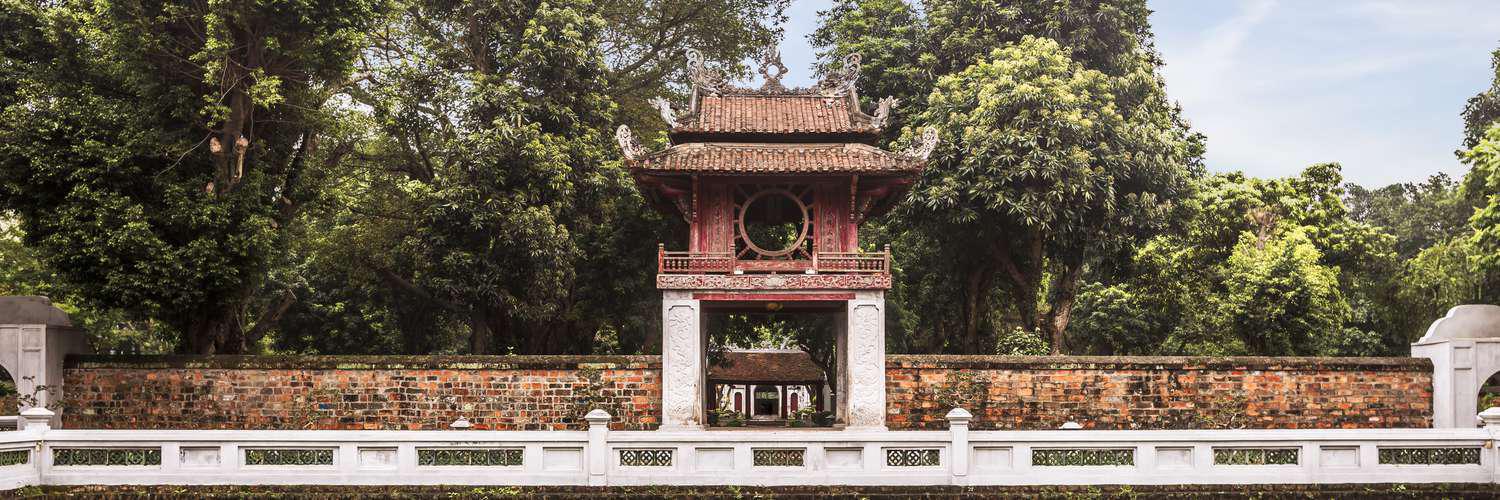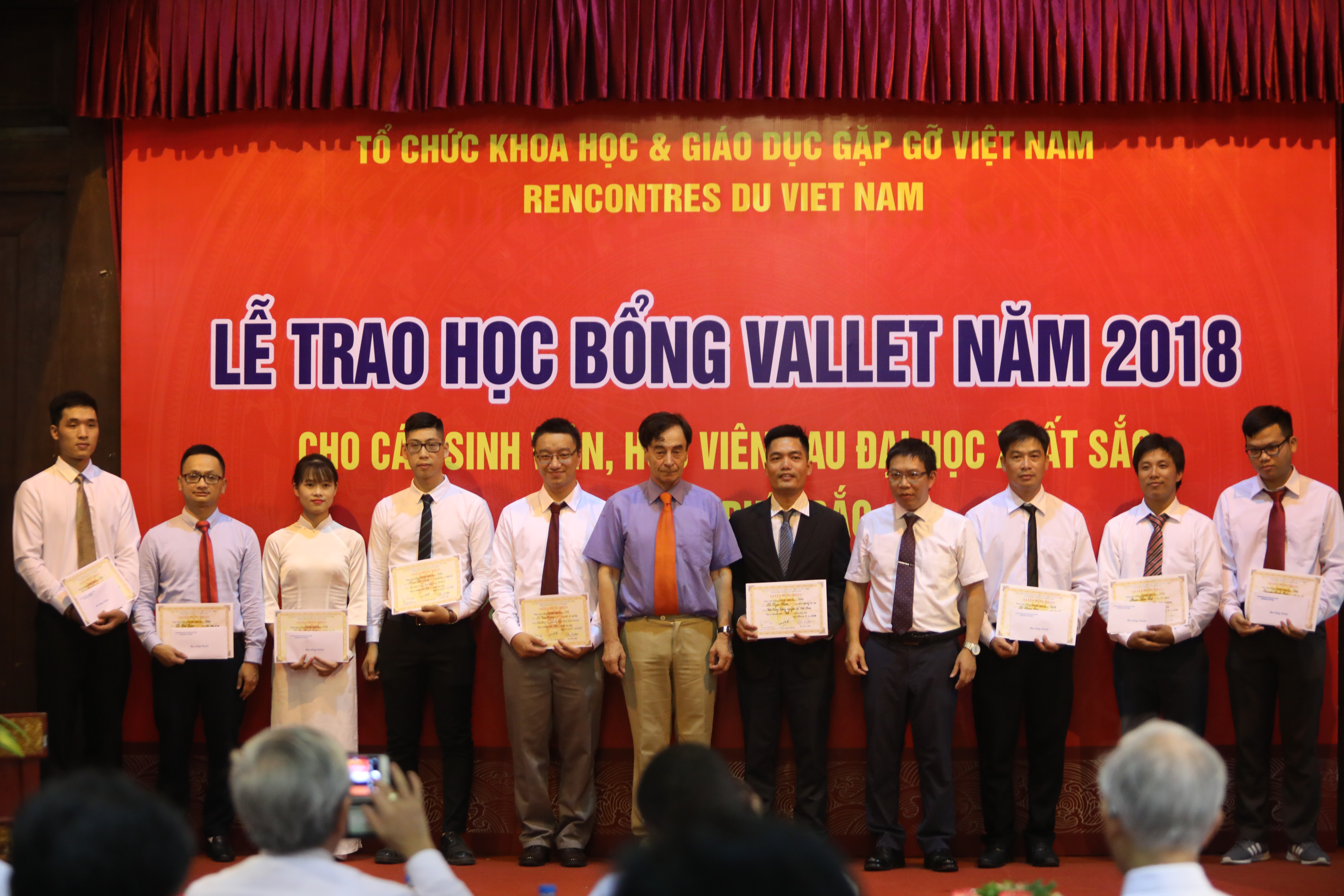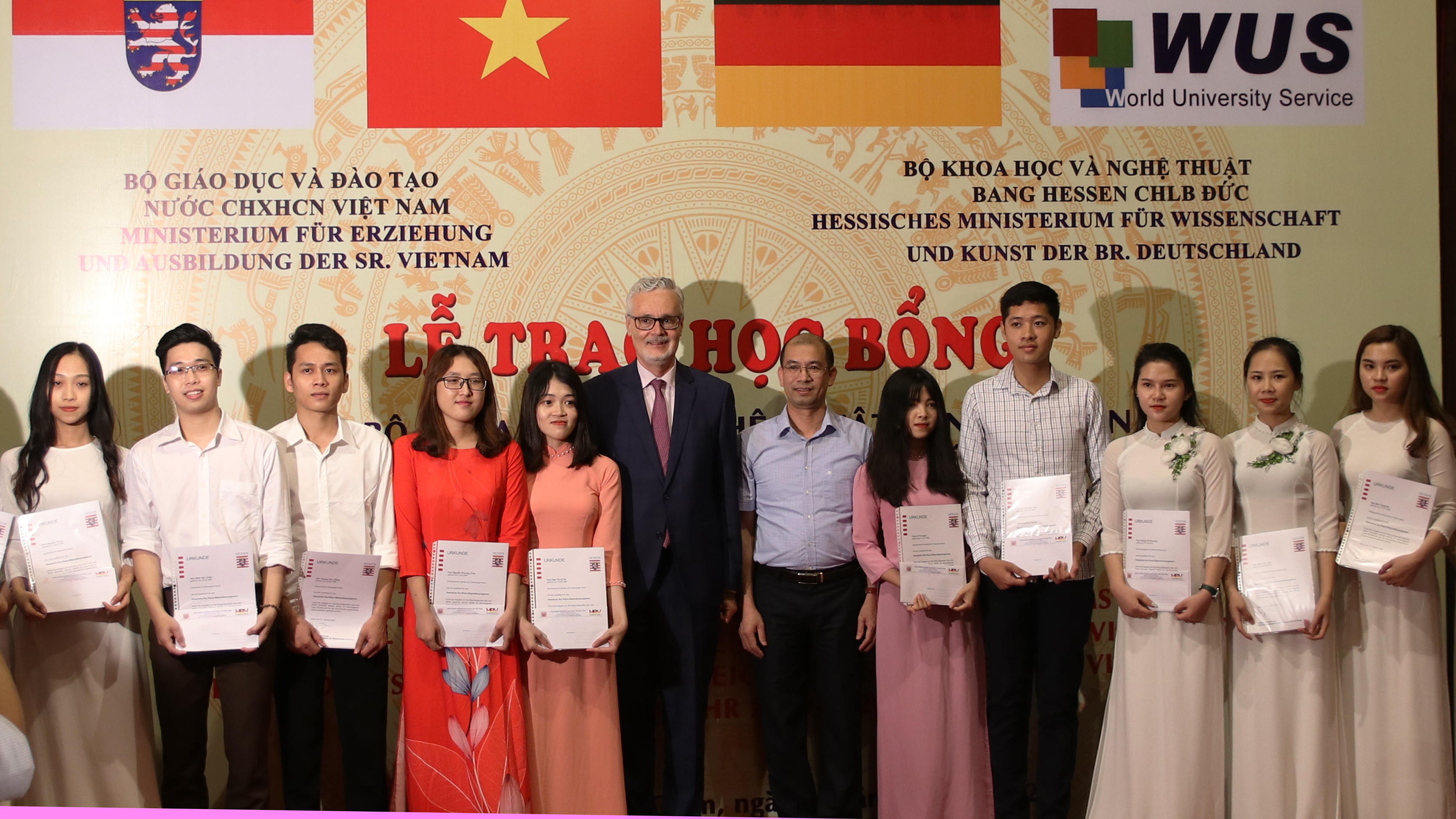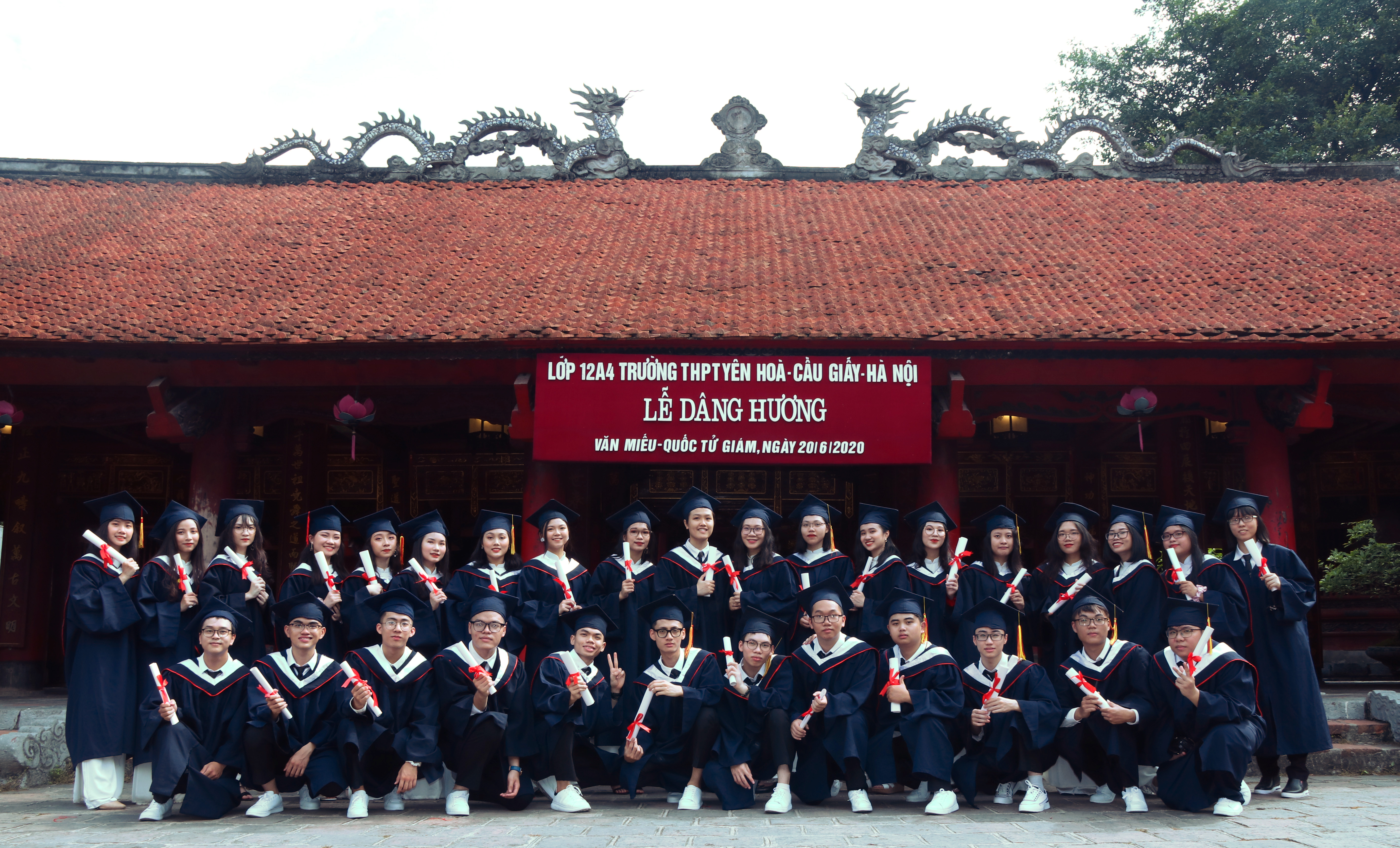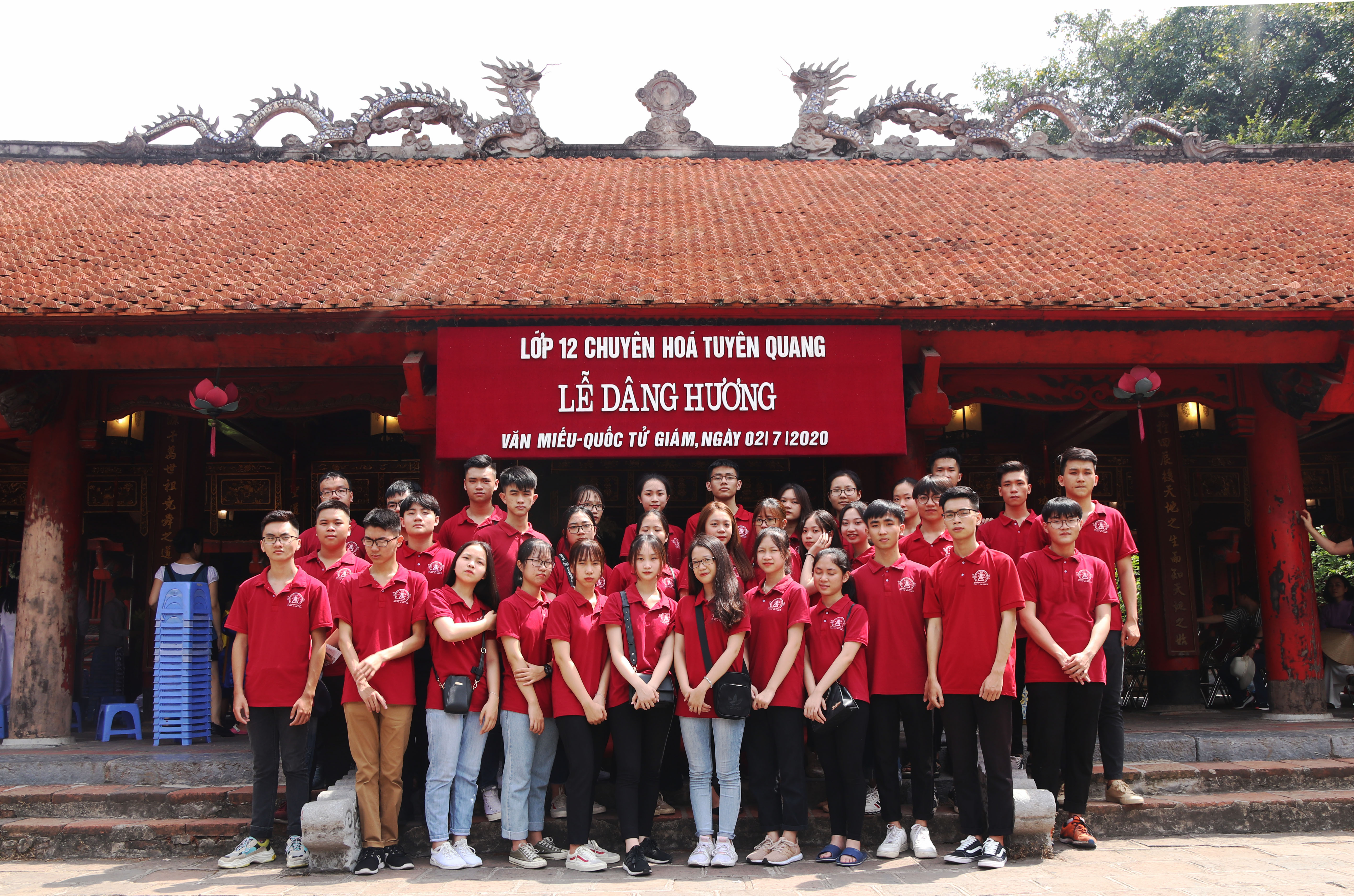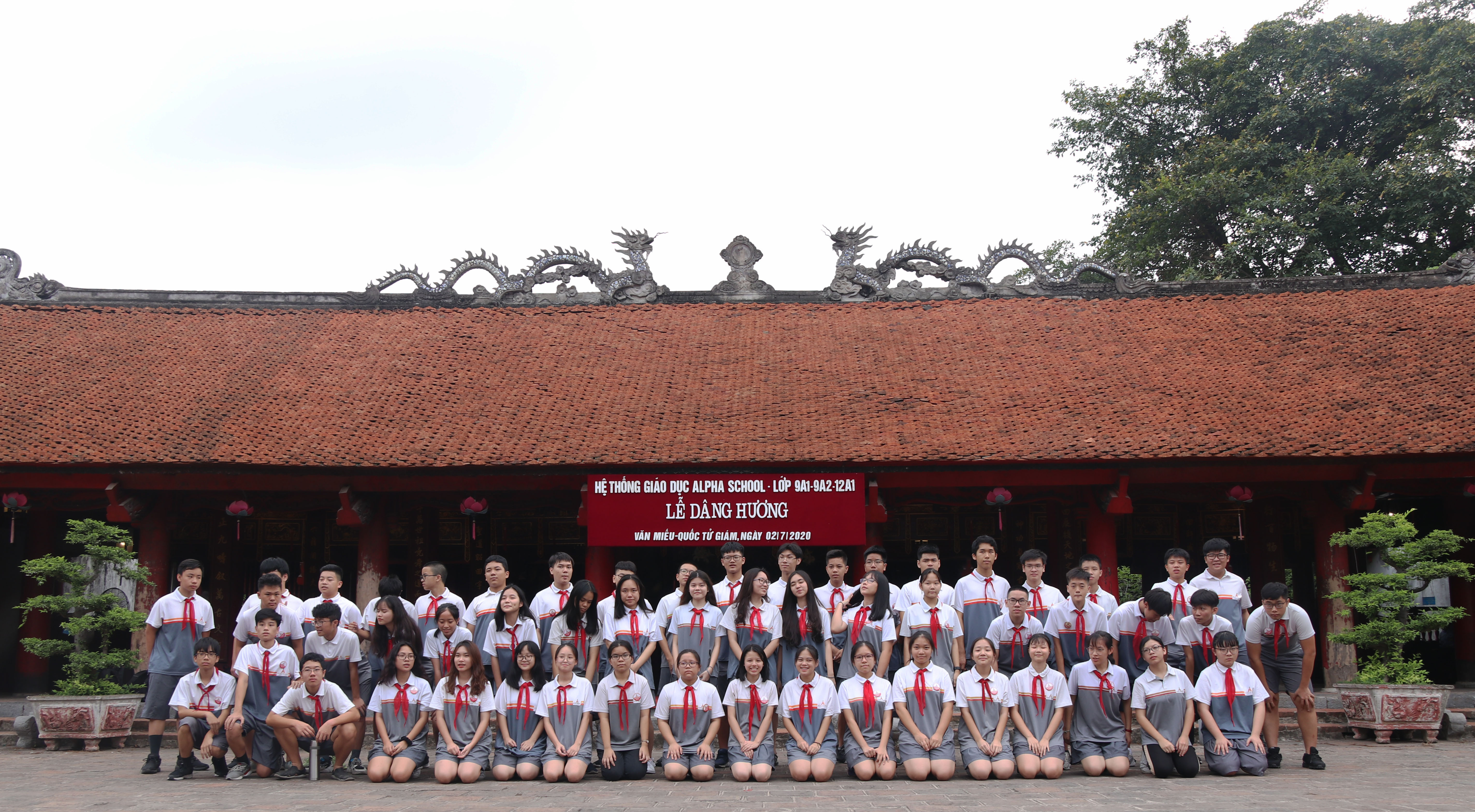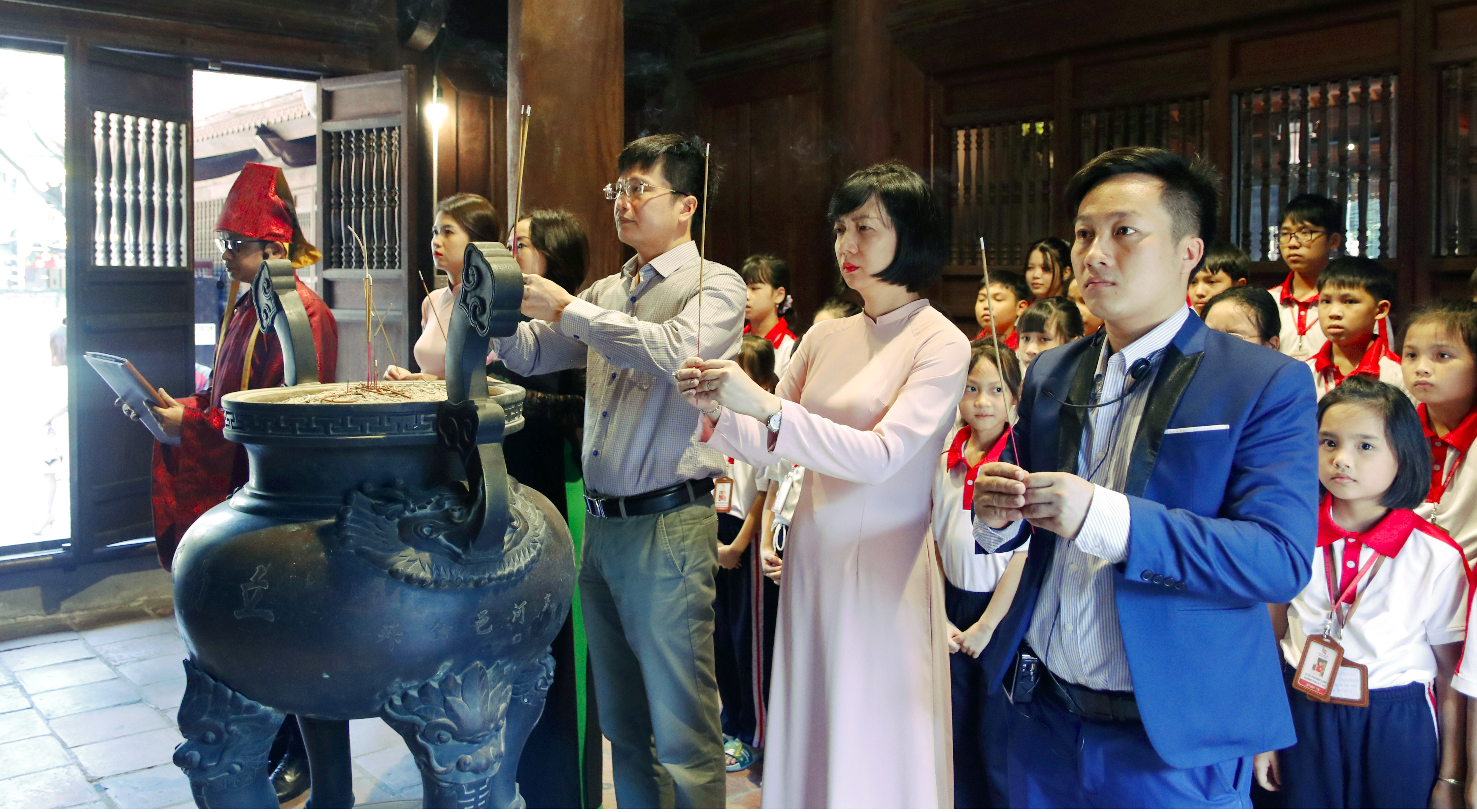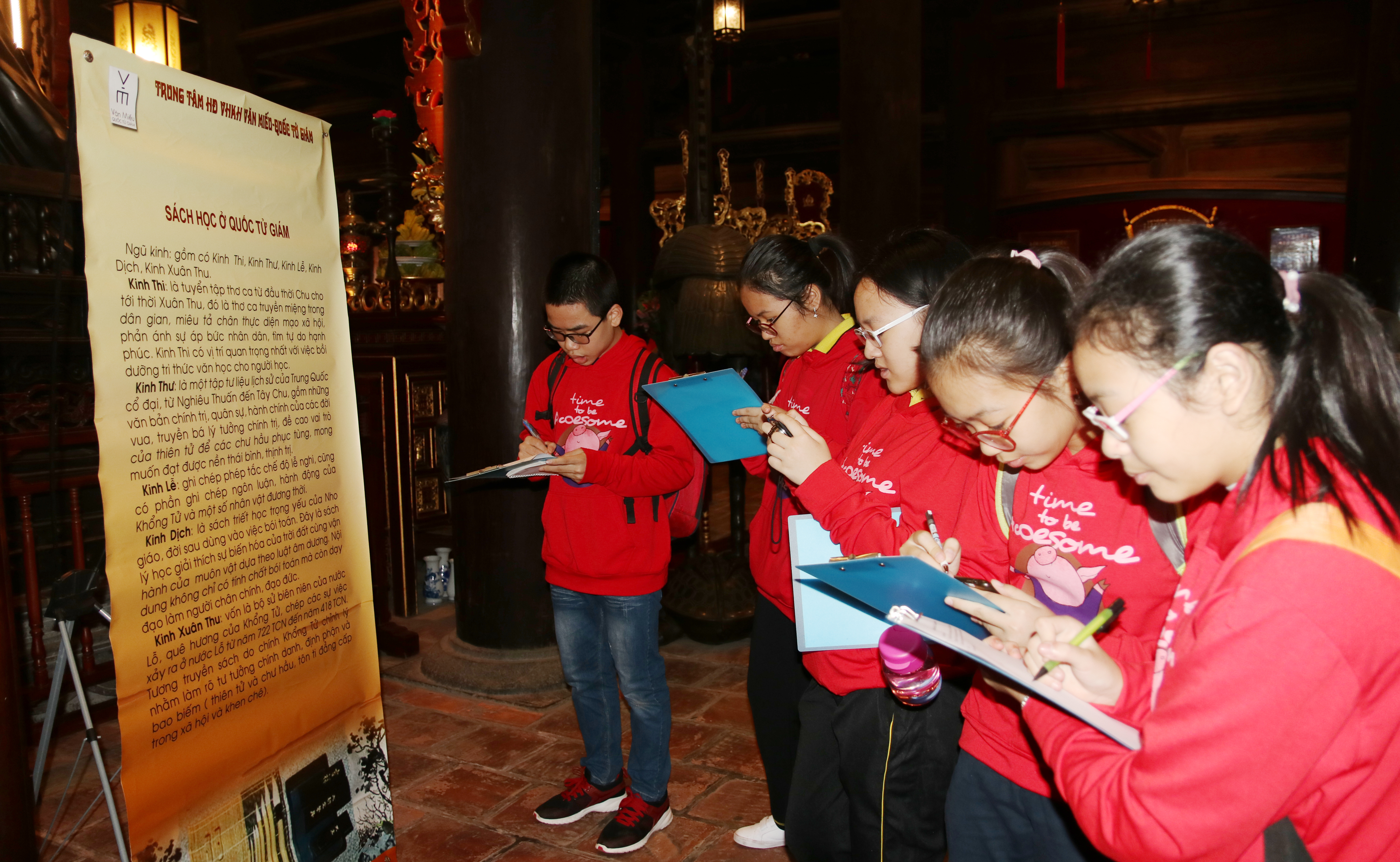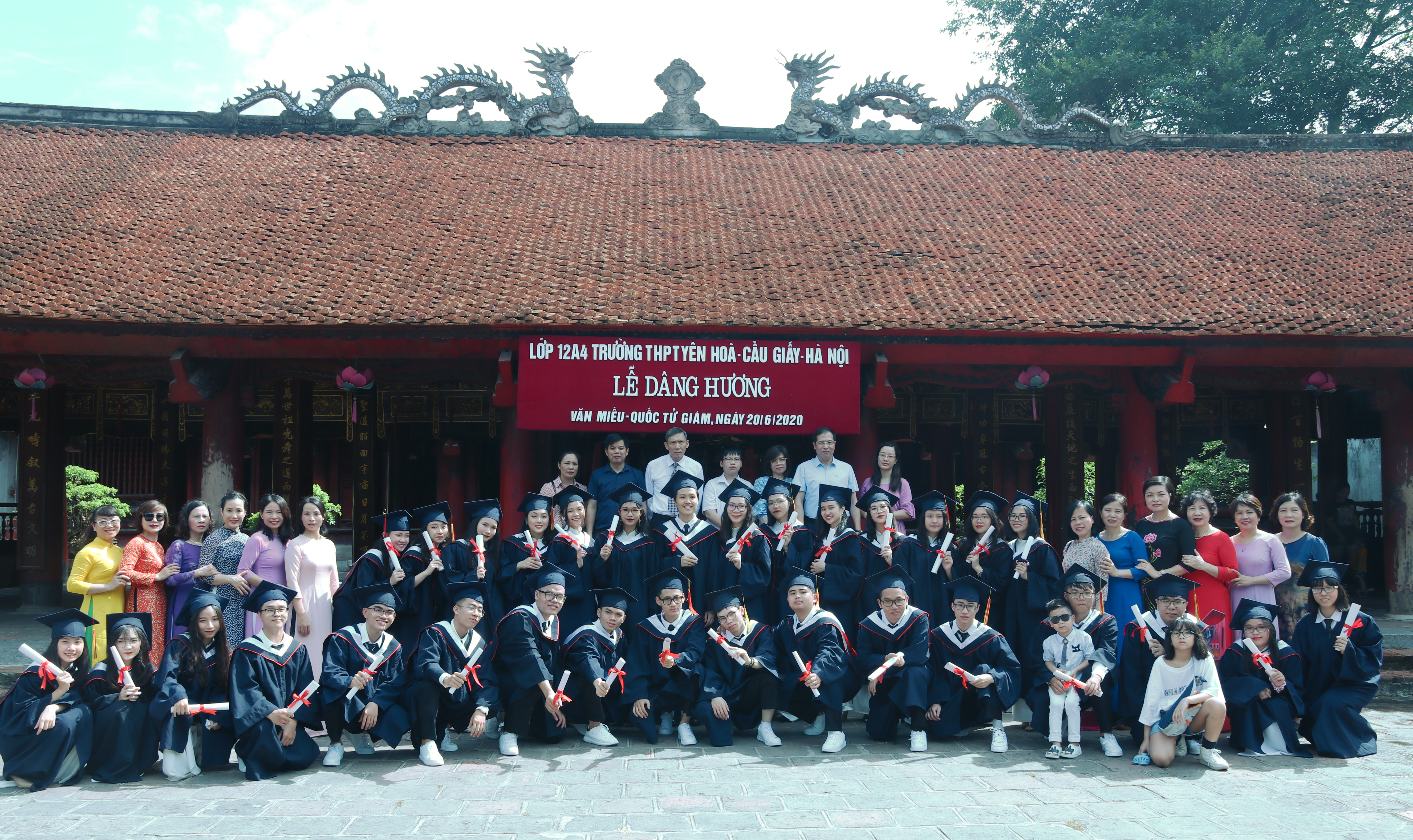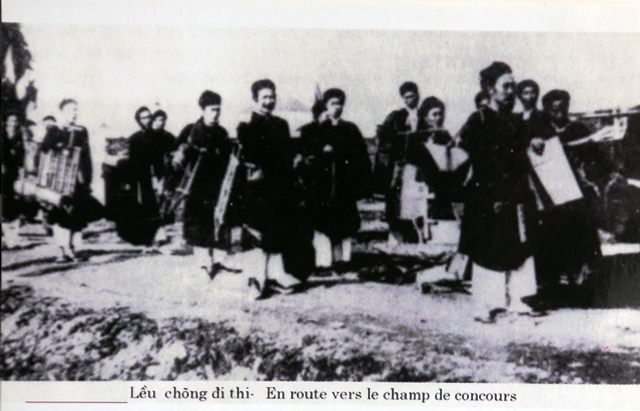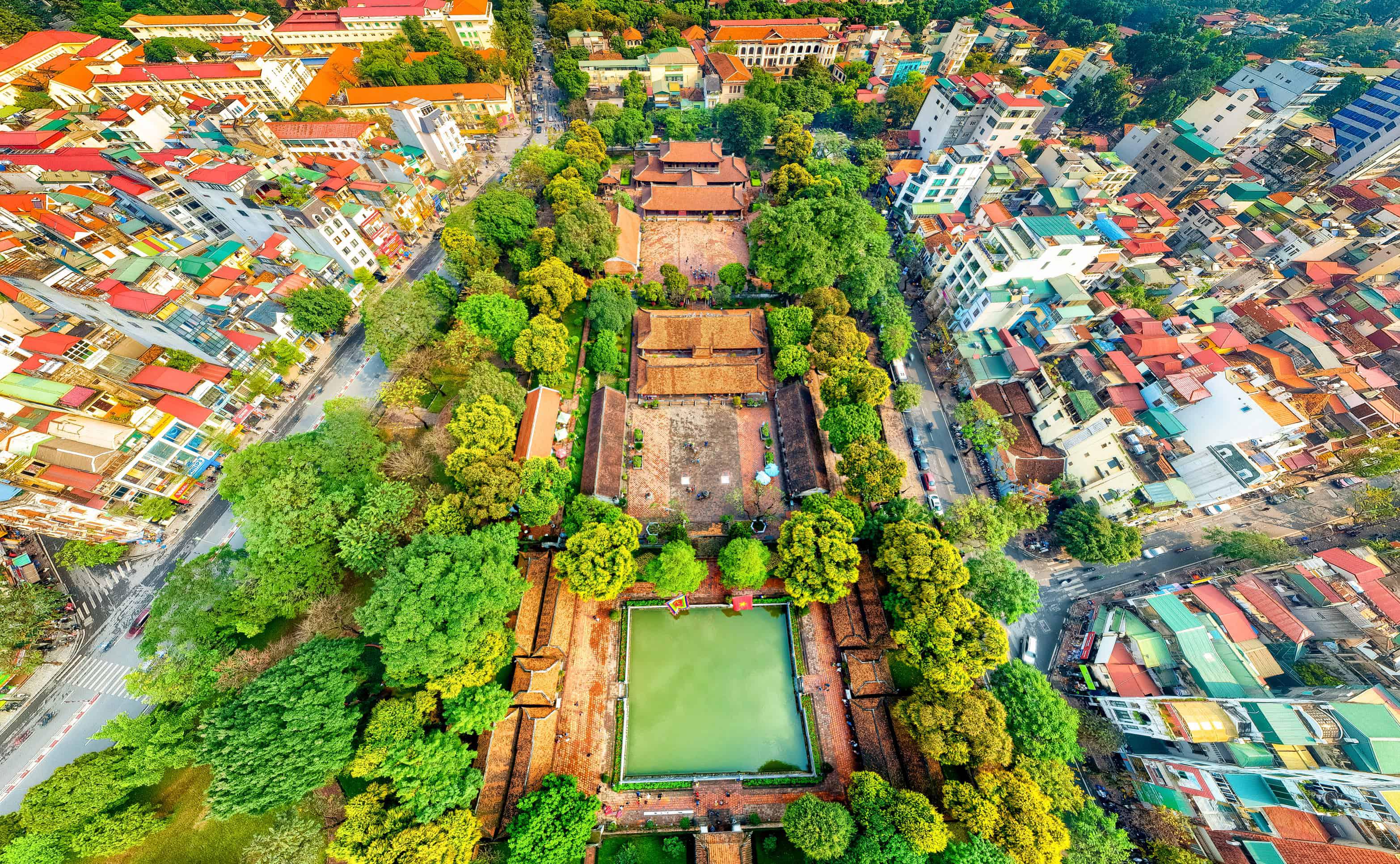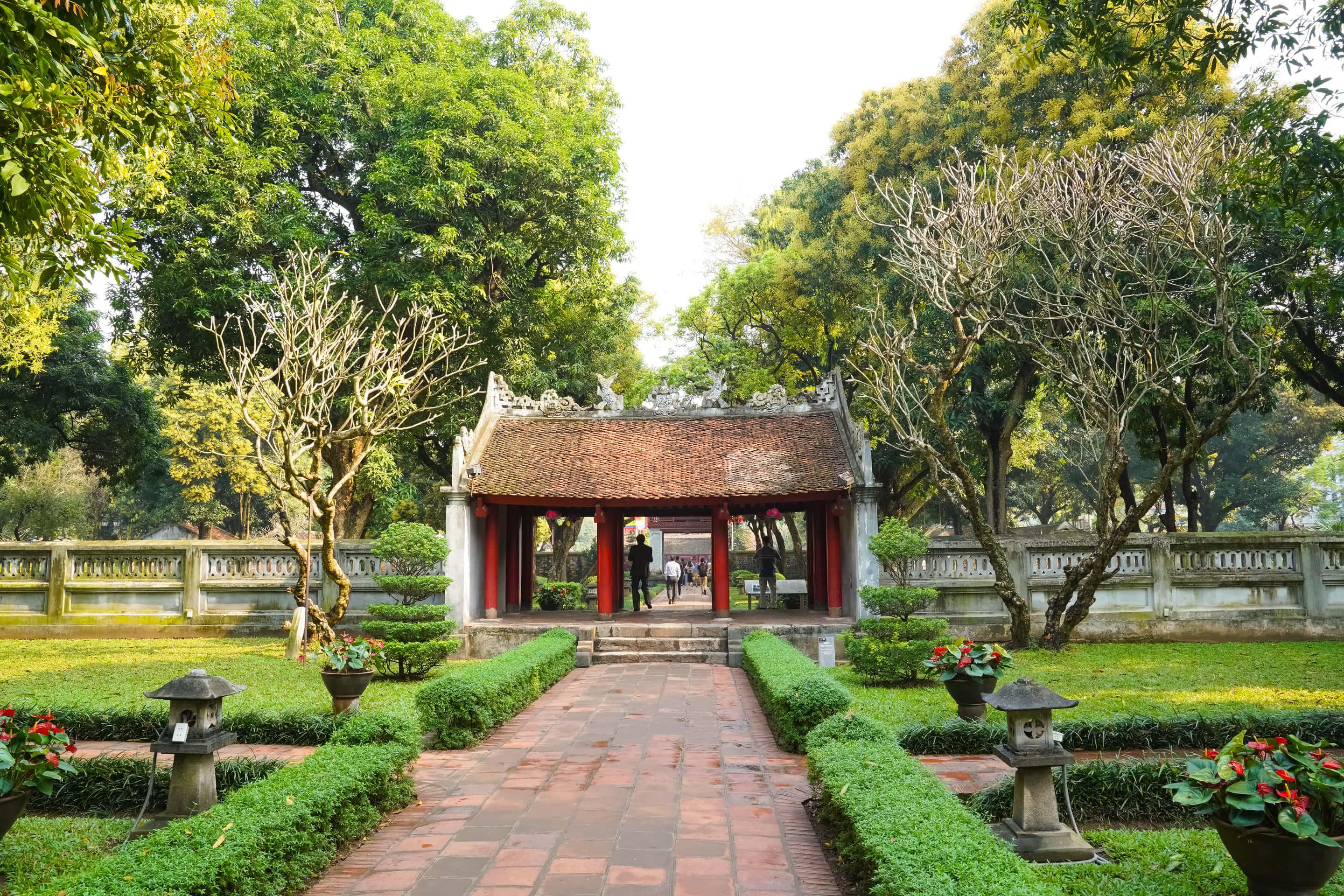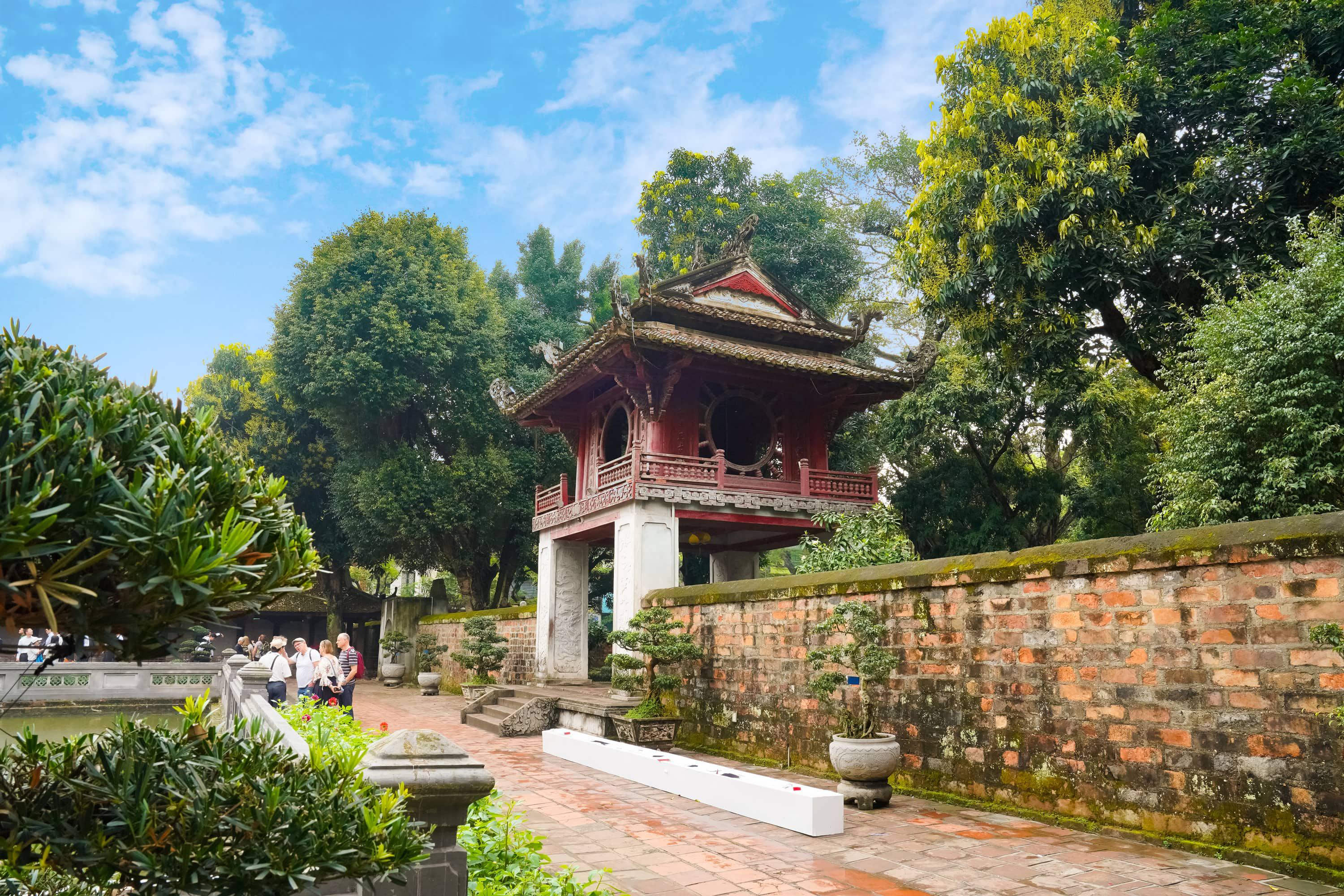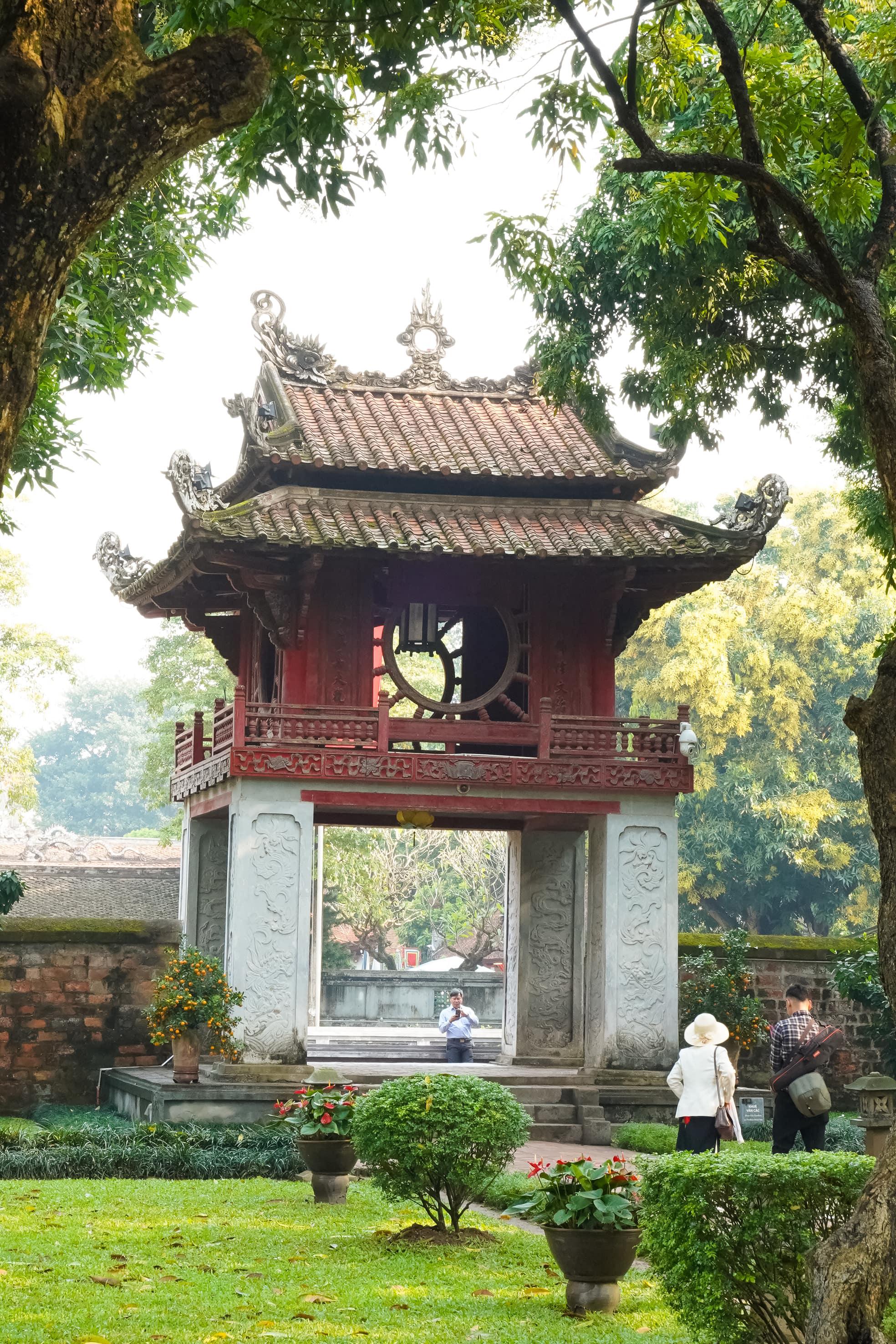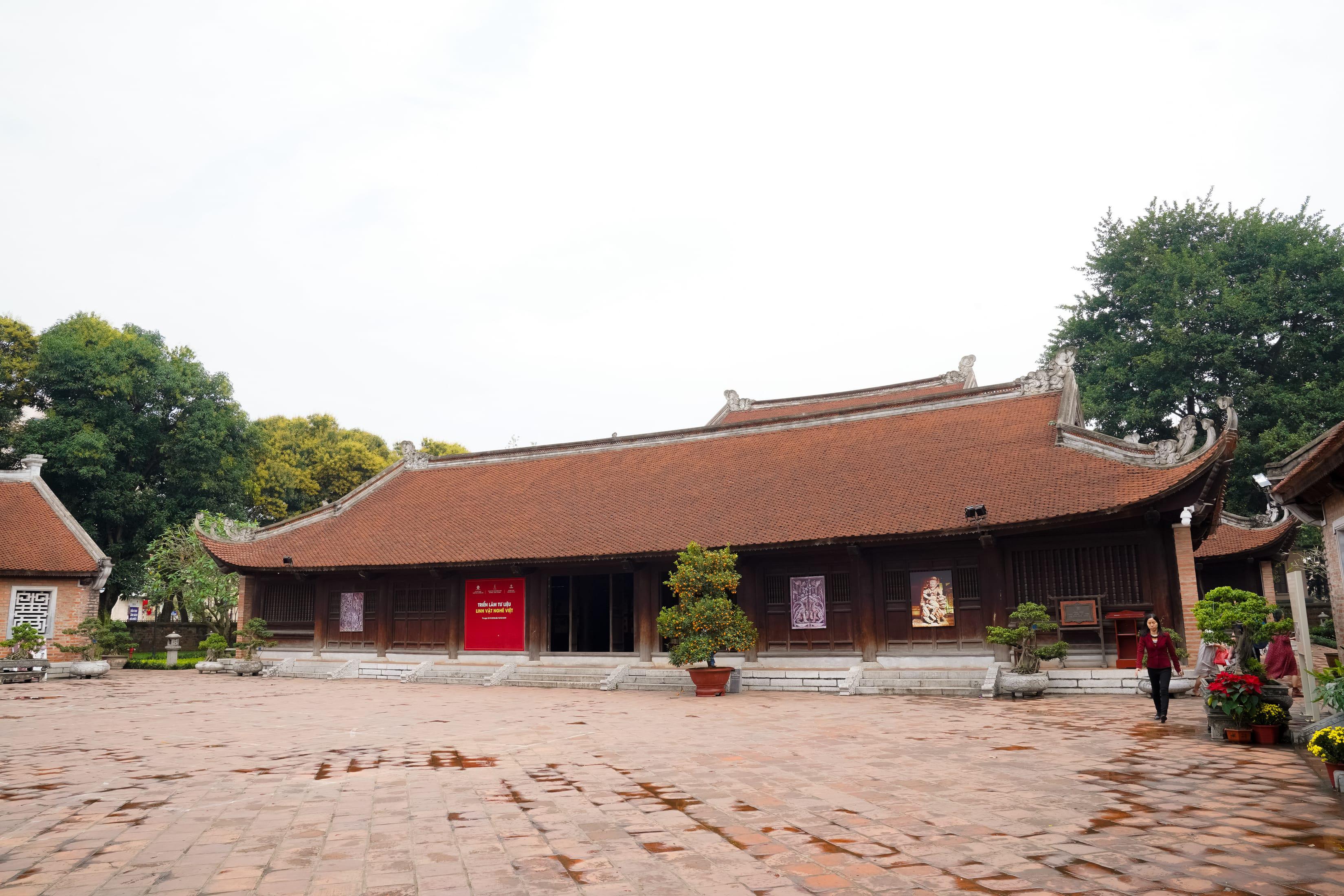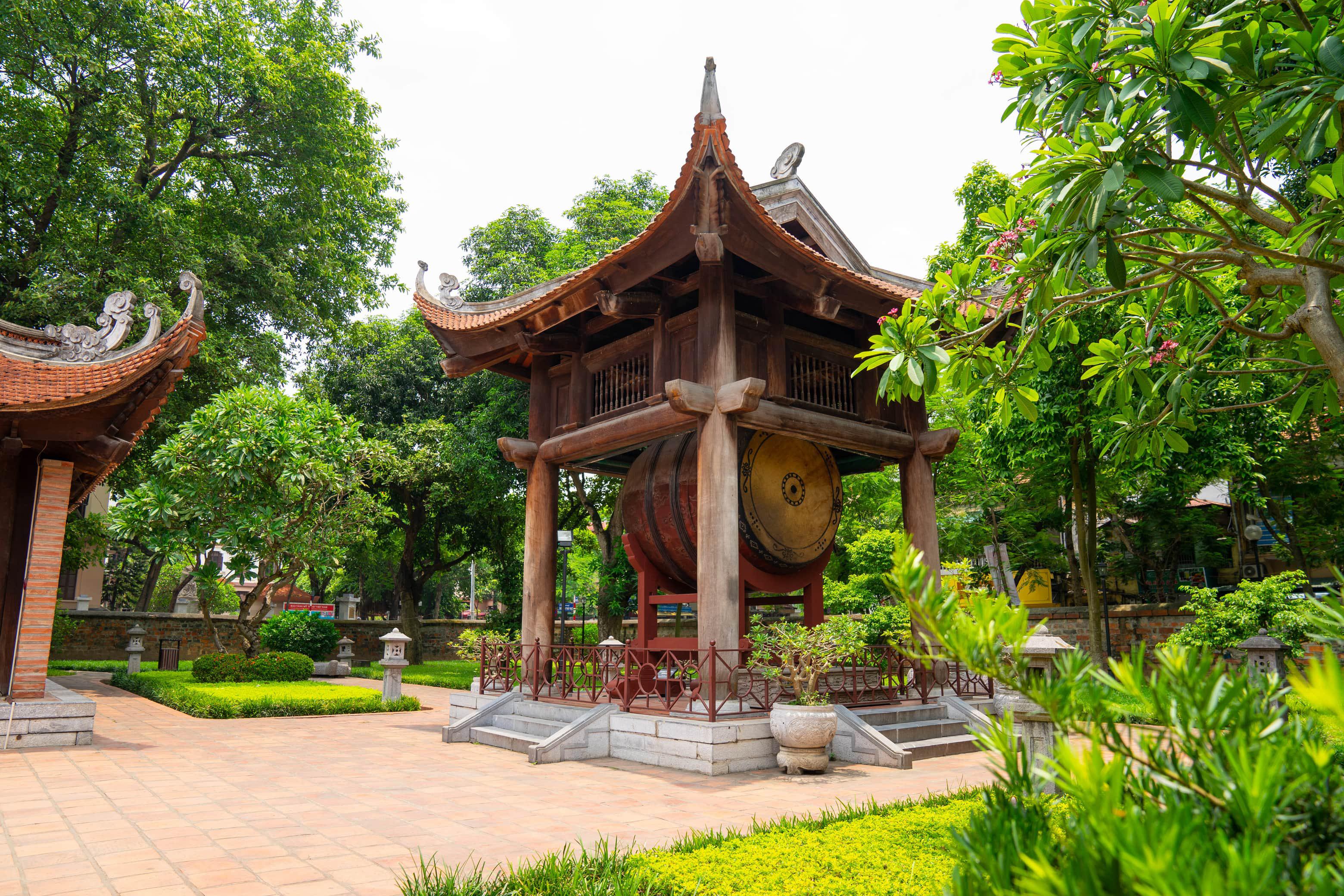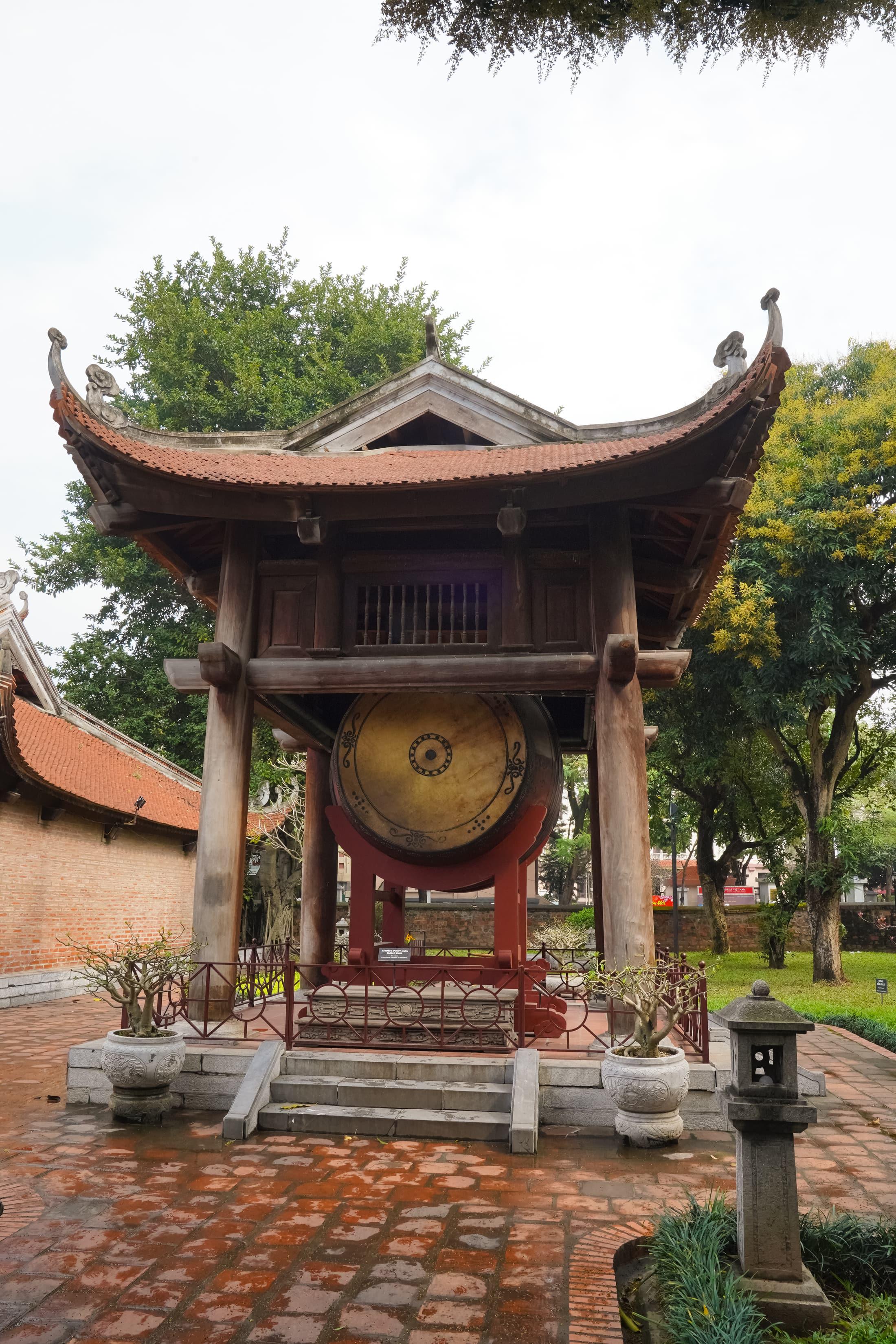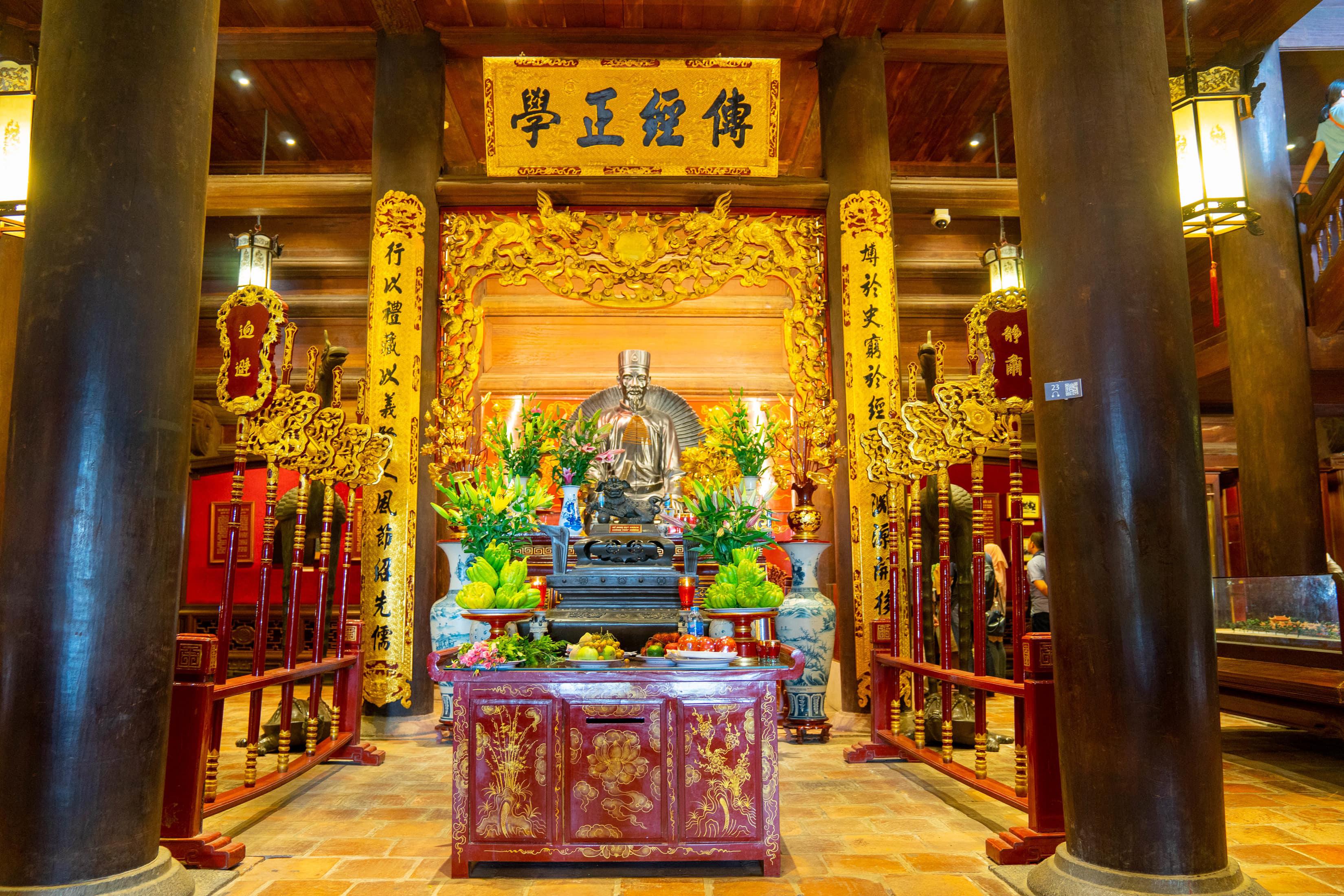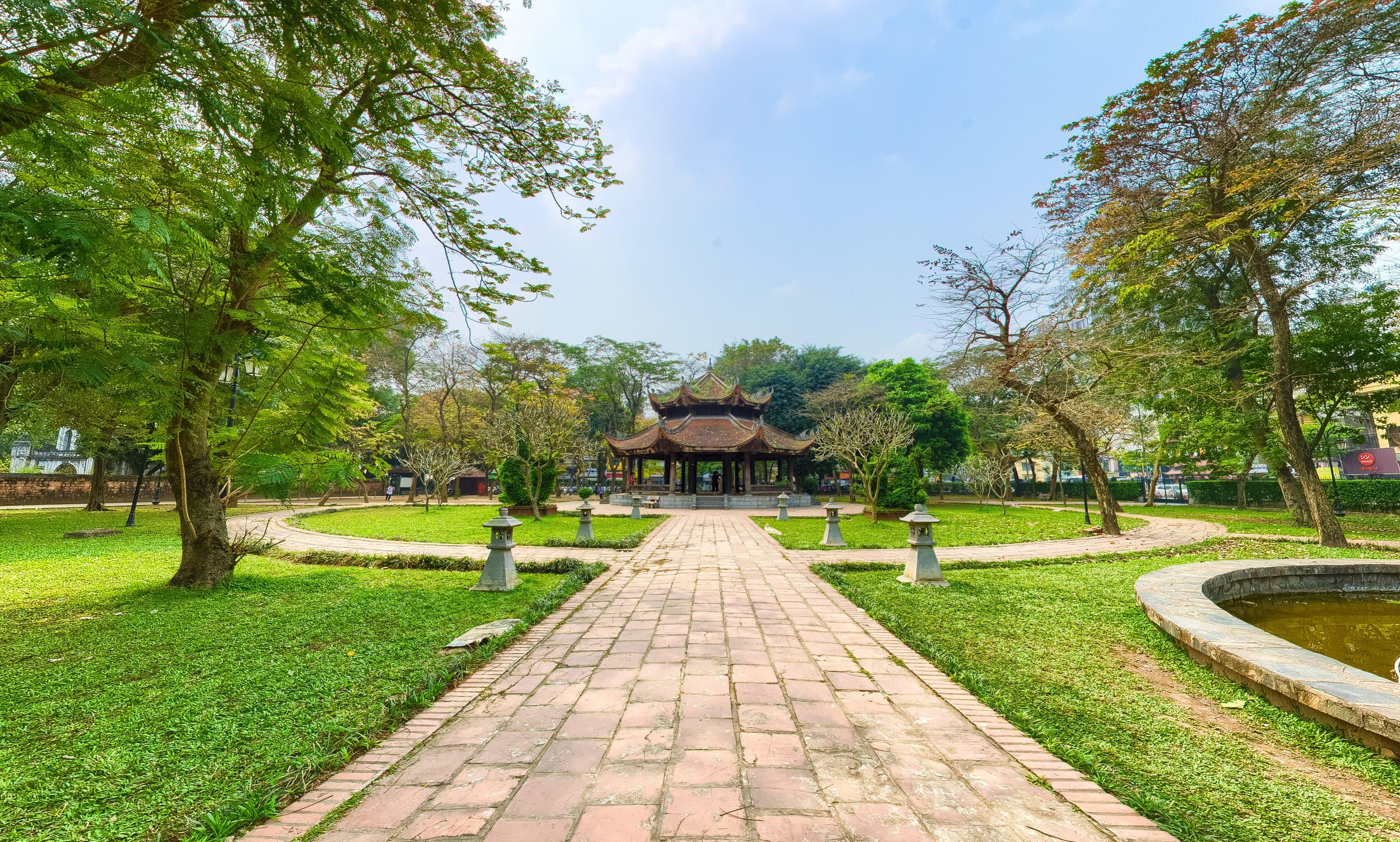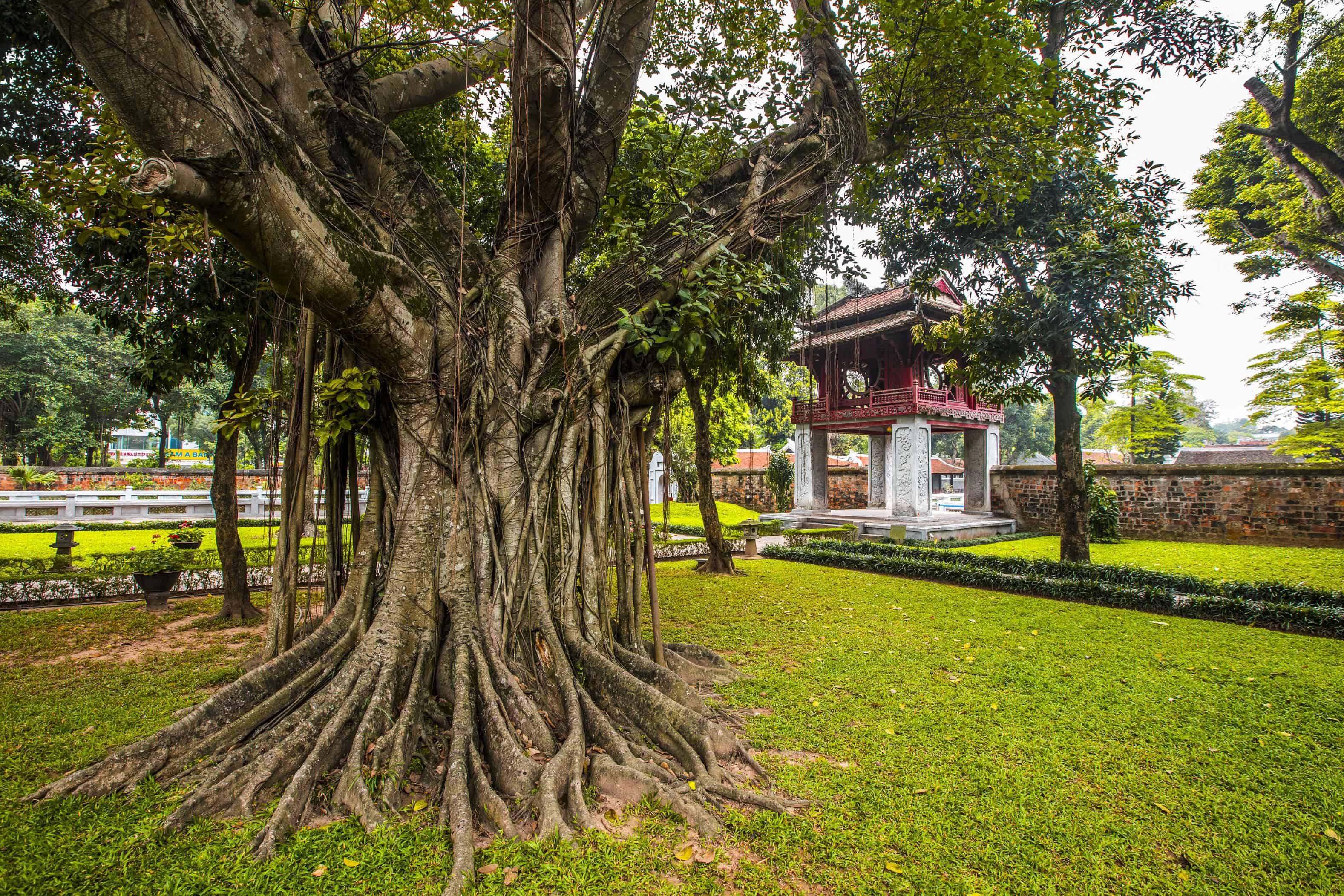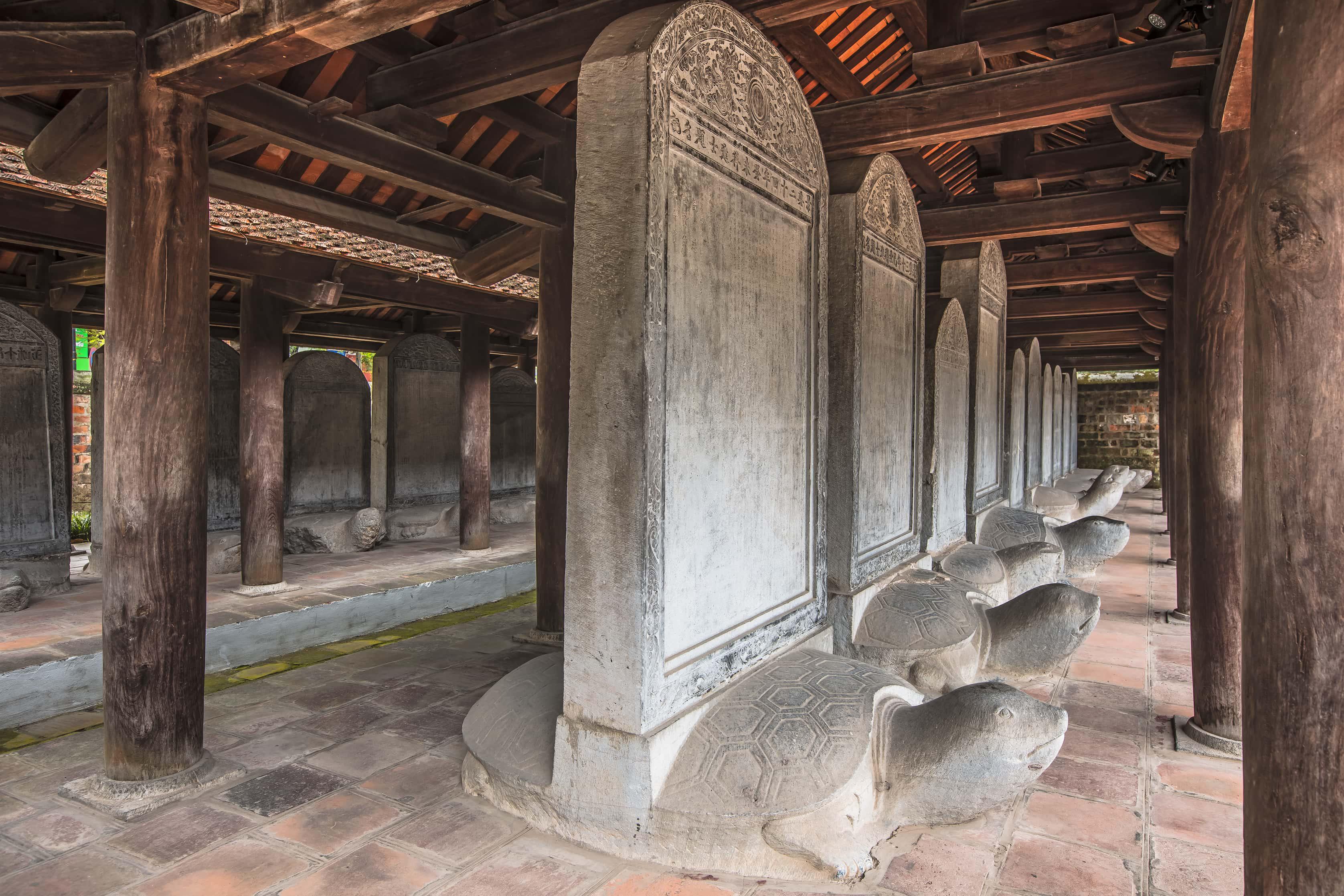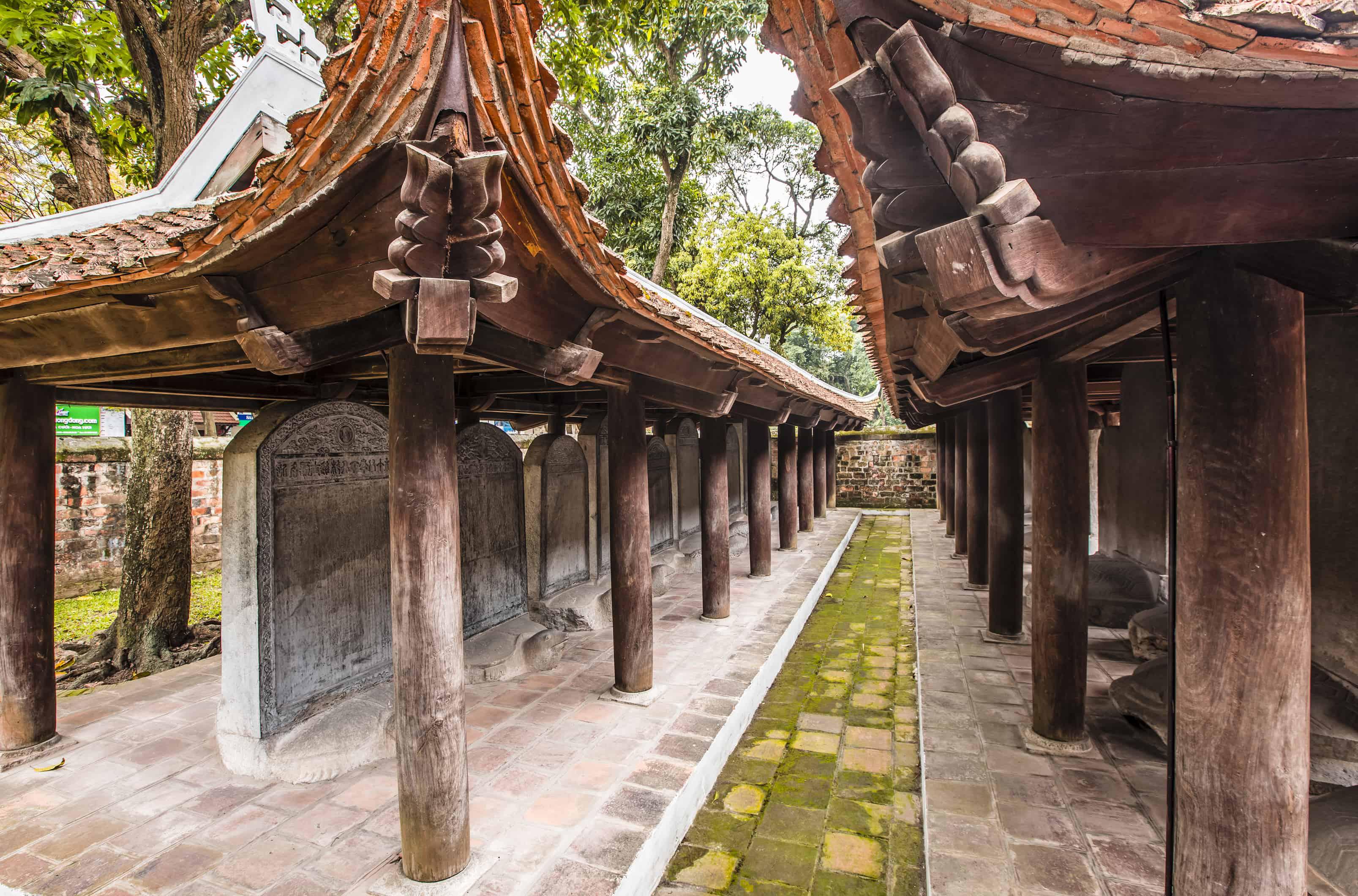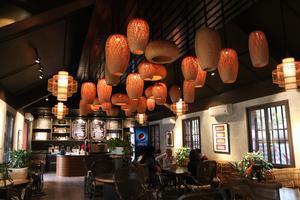CHUÔNG VÀ TRỐNG SẤM TẠI VĂN MIẾU –QUỐC TỬ GIÁM
Ngày nay đến tham quan di tích Văn Miếu-Quốc Tử Giám, du khách sẽ thấy ở hai bên nhà Hậu đường, khu Thái Học có Lầu chuông bên phải và Lầu trống bên trái, bên trong có treo một chiếc chuông và trống.
Chuông cao 2,34m, đường kính đáy chuông 1,28m, trọng lượng 1970 kg, được đúc liền khối nguyên chất. Chuông do các nghệ nhân thành phố Huế thực hiện vào năm 2008. Quai chuông hình rồng, thân chuông có nhiều viền kẻ dọc chạy từ trên xuống chia chuông thành bốn phần rõ rệt, cùng với đó là những đường kẻ ngang, bên dưới trang trí hoa văn hình “thư kiếm”. Có một điều đặc biệt là thân chuông đúc nổi hai bài minh viết về lịch sử của di tích Văn Miếu – Quốc Tử Giám và truyền thống hiếu học của dân tộc Việt Nam.
Trống có chiều cao 2,65 m, đường kính mặt trống là 2,01m. Trống do các nghệ nhân làng Đọi Tam, tỉnh Hà Nam thực hiện nhân dịp kỷ niệm 990 năm Thăng Long –Hà Nội. Tang trống được ghép bằng 50 thanh gỗ của cây mít 300 năm tuổi, mỗi thanh có chiều rộng 17cm. Mặt trống được bưng bằng da của hai con trâu mộng 15 tuổi, mỗi con nặng khoảng 600kg. Trống được gọi là Trống Sấm vì tiếng trống rền vang và uy vũ như sấm trời. Đây cũng là trống to nhất Việt Nam vào những năm 2000.
Chuông và Trống được đặt trang trọng tại khu Thái học, trên nền của Quốc Tử Giám xưa. Ngày nay, đây là nơi lưu giữ và tiếp tục phát huy các giá trị tốt đẹp của dân tộc, trong đó có truyền thống hiếu học, hiếu nghĩa, tôn sư trọng đạo, coi trọng hiền tài của dân tộc Việt Nam.
Lầu Chuông
Lầu Trống
Thúy Hồng
THE BRONZE BELL OF BICH UNG AND STONE GONG - PRECIOUS ARTIFACTS AT VĂN MIẾU – QUỐC TỬ GIÁM
At the Ceremony house of Văn Miếu – Quốc Tử Giám, currently houses two precious artifacts: the Bich Ung bell cast in 1768 hanging at the eastern end of the courtyard, and a stone gong from the 19 century hanging at the western end of Ceremony househouse.
According to historical records, in 1768, the principal of Quốc Tử Giám (the first national university), Nguyễn Nghiễm, along with other scholar-officials of Quốc Tử Giám, sought permission from the royal court to cast a large bell and four small bells for Văn Miếu – Quốc Tử Giám. Over time, the four small bells have been lost, leaving only the large Bich Ung bell.

The Bich Ung bell is 109cm tall, with a 56cm diameter mouth. It has a double-headed dragon-shaped bell handle and a cylindrical body divided into four panels. The lower part of the bell is adorned with raised lines, corners, and rims of decorative floral patterns. The bell's base flares out, decorated with double lotus petal patterns. It has four raised strike knobs around it, each adorned with floral patterns. The shoulder of the bell is engraved with the four characters: "Bích Ung đại chung". This bell is very precious, its clear and melodious sound demonstrating its quality crafted from excellent materials.
The Stone gong was made during the Nguyễn dynasty (19th century). Both sides of the stone gong are decorated with floral patterns: the upper part features wave-like patterns, and the shoulders have leaf designs, with two knobs on each shoulder adorned with lotus flower patterns. The front is inscribed with Chinese characters, while the back bears the characters "壽昌" (Thọ Xương).

The combination of the bronze bell and stone gong symbolizes intelligence and human virtues. Nowadays, visitors to Văn Miếu – Quốc Tử Giám can admire these two precious artifacts and listen to their unique sounds during special ceremonies held throughout the year.

Ceremony house
LH
STUDYING AT QUỐC TỬ GIÁM
The organization of teaching and learning at Quốc Tử Giám - the first National University began in 1076 during the Lý dynasty, developed and perfected during the Lê dynasty (15th-18th centuries). During the Lý and Trần dynasties, there are few records about the activities of the National University, making it difficult for us to accurately imagine the content of teaching and learning during this period. It is known that the court selected Confucian scholars knowledgeable in the Confucian classics to teach students at the National University.
In the Lê dynasty, teaching and learning at the National University were organized systematically and rigorously. Twice a month, the officials of the National University would conduct lectures on the Confucian classics and historical stories in class. During the remaining time, students had to study on their own, conduct research, and practice writing. Examinations (small essays) were conducted once a month, and students could either complete the writing exercises in class or take them home, then submit them to the officials.
The officials would grade the essays and categorize the results into three types: excellent, average, and below average. The below-average category was further divided into three types. The truly outstanding essays, along with the teacher's comments, were selected to be read during literary critique sessions held at the school on the days of The 1st and 15th days of the lunar month. These literary critique sessions were usually organized ceremoniously, inviting court officials and scholars to attend. The essay topics were often related to national governance issues such as ethics, administrative rituals, rulers' governance, teaching principles, etc.
Additionally, on the 4th day of the 3rd month of each quarter, students had to complete a major essay. The results of these essays were compiled to serve as a basis for selecting candidates for further examinations or for promotions and appointments.
The curriculum at the National University lasted for a minimum of 3 years, corresponding to the time Confucian scholars spent studying before taking the Imperial examinations. The National University was a prestigious educational institution and the educational authority of the court in the capital city, and its educational content strictly adhered to regulations. It fulfilled the requirements of training officials for the court while serving as a model for other schools in various regions.
In addition to the Confucian classics, textbooks used for teaching at the National University included works on government decrees, selected ancient poetry and literary works, etc. Alongside studying the classics, students were regularly trained in various writing styles used in examinations.
The teaching and learning content at the National University fully met the requirements of a high-level educational institution. With over 700 years of history, the National University contributed significantly to educating numerous talented scholars and officials for the country.
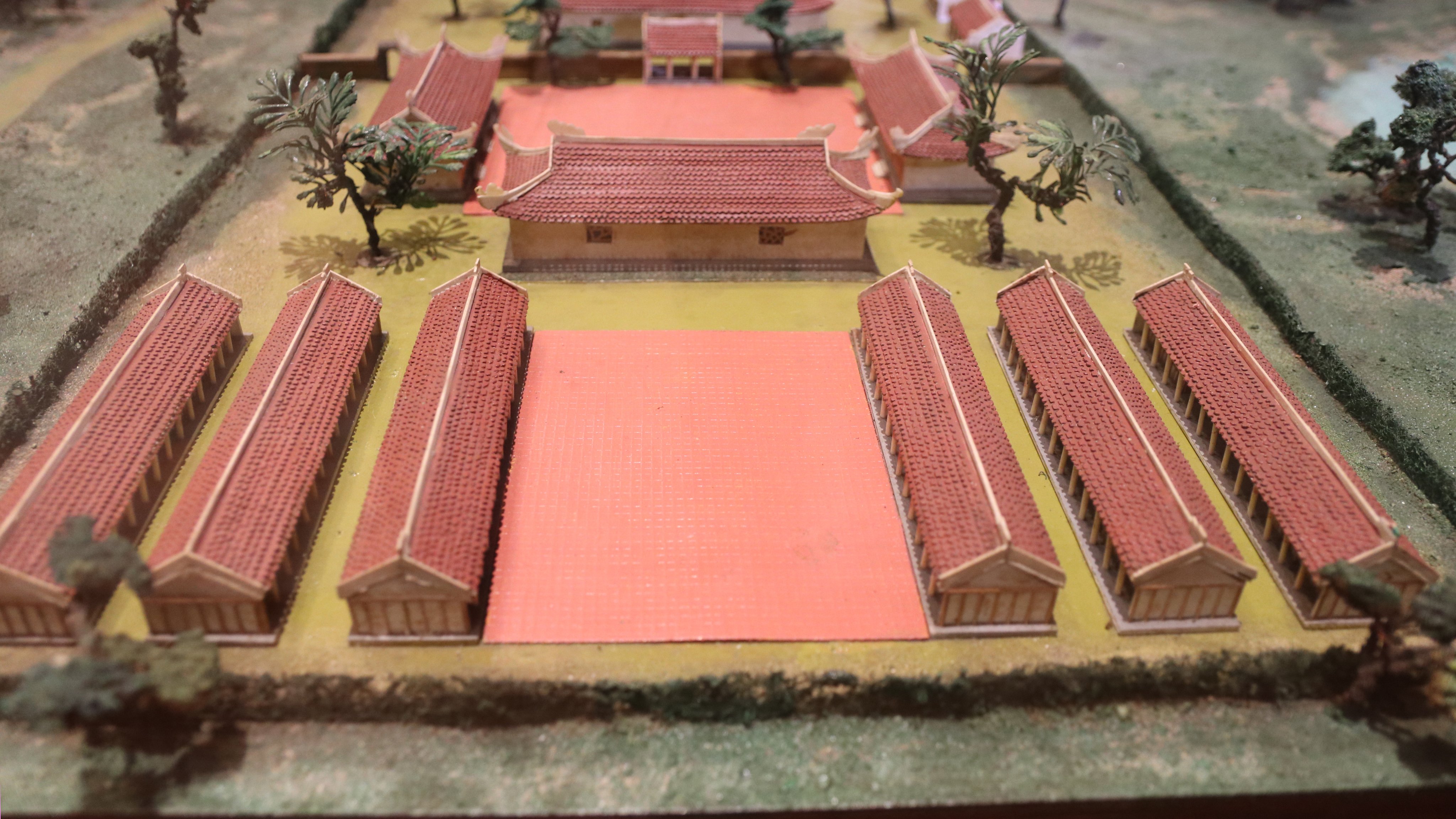
LH
TEACHERS AT QUỐC TỬ GIÁM – THE FIRST NATIONAL UNIVERSITY
Quốc Tử Giám was built in 1076. With over 700 years of existence, it is Vietnam's first national school and the largest center for advanced Confucian education during the feudal era. The administration and teaching at Quốc Tử Giám were carried out by Confucian scholars and officials such as (head master), Tư nghiệp (deputy head master), and teachers like Bác sĩ, Trực giảng, Trợ giáo, Giáo vụ, Giáo thụ, Huấn đạo... These were individuals known for their profound knowledge, moral integrity, and were often selected from among the highest-ranking officials and scholars, including Doctoral laureates.
However, the criteria for selecting teachers at Quốc Tử Giám evolved and improved throughout different dynasties. The Đại Việt sử ký toàn thư, a historical record, not only mentions that Crown Prince came to Văn Miếu to study in 1070 but also notes that in 1076, the king appointed officials who were literate to teach at Quốc Tử Giám. Therefore, the selection of teachers at Quốc Tử Giám during the Lý dynasty already involved educated individuals.
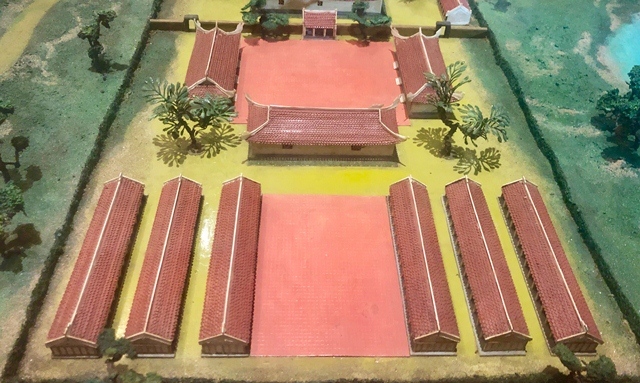
During the Trần dynasty, the standards for teaching in Quốc Tử Giám emphasized the importance of selecting teachers who were highly respected, knowledgeable, and well-versed in classical texts. The Vietnamese historical records note that in the year of Chính Bình in the reign of Trần Thánh Tông, the Trấn dynasty appointed Phạm Ứng Thần as the Chief Scholar and established the Quốc Tử Viện (the National University) as a formal educational institution for the children of government officials.
In addition, the king also invited Confucian scholars from within the country to Quốc Tử Viện to lecture on the Four Books and the Five Classics. In 1272, King Trần Thánh Tông issued an edict to seek talented, virtuous individuals who were knowledgeable in classical texts to lead the Quoc Tu Giam, and they were tasked with explaining the meaning of the Four Books and the Five Classics to students.
Furthermore, the Trần dynasty introduced the position of Quốc Tử Giám Trợ Giáo (teachers), with individuals like Đoàn Xuân Lôi serving in this role in 1392 during the reign of Trần Thuận Tông. Later, during the Lê dynasty, the same position was retained, with figures like Nguyễn Siêu appointed as Trợ Giáo in 1449.
It was during the Trần dynasty that the position of Tư nghiệp (Principal) was established as the head of Quốc Tử Giám. The criteria for appointing a Tư nghiệp demanded both high intellectual capabilities and moral integrity. This standard continued to be maintained and applied by subsequent feudal dynasties in Vietnam.
In 1400, Hồ Quý Ly ascended to the throne. During the 7 years of the Hồ dynasty's existence (1400-1407), there were few changes in the policies for recruiting personnel into Quốc Tử Giám. At the head of Quốc Tử Giám remained the official known as Tư nghiệp. This position was held by Nguyễn Phi Khanh (1355-1428), a resident of Nhị Khê village in Quốc Oai district.
The expansion and development of Confucian education in our country reached its peak during the Lê dynasty. Right after his coronation in 1428, King Lê Thái Tổ began selecting the descendants of officials and commoners to study at Quốc Tử Giám (referred to as Giám sinh). During the Lê dynasty, Quốc Tử Giám was renamed Thái Học viện or Thái Học. At this time, the selection of teachers for Quốc Tử Giám was specified with clear standards. At the head of the Quốc Tử Giám Thăng Long under the Lê dynasty was the Tế tửu who could be considered equivalent to a principal.
In terms of their responsibilities, both the Quốc Tử Giám Tế tửu and Quốc Tử Giám Tư nghiệp were entrusted with looking after Văn Miếu, cultivating scholars, nurturing talent, and aiding in domestic recruitment. Tế tửu officials, in particular, played a leading role in the ceremonial rituals at Văn Miếu. This helps us understand that during the Lê dynasty, Tế tửu officials, who headed Văn Miếu and Quốc Tử Giám, had the responsibility of overseeing both the ceremonial rituals at Văn Miếu and the educational activities at Quốc Tử Giám.
Participation in teaching at Quốc Tử Giám also involves various academic officials such as Trực giảng, Bác sỹ, Trợ giáo, Giáo vụ, Huấn đạo, Giáo thụ...
Trực giảng at Quốc Tử Giám holds a position below Tư nghiệp (deputy head master
Bác sỹ at Quốc Tử Giám was taken on by individuals well-versed in classical texts. Besides imparting knowledge to students, this role may involve political advising and ritual duties.
Trợ giáo at Quốc Tử Giám assists Bác sỹ in imparting Confucian studies and the Four Books to students.
For the convenience of teaching, starting in 1693, Tế tửu, Tư nghiệp, Giáo thụ, and Ngũ kinh Bác sĩ (Doctors of the Five Classics) resided at Quốc Tử Giám to provide daily guidance to the scholars. On the first and fifteenth days of each month, they practiced essay writing, and during the four major exams (Trọng xuân - february of the lunar calendar, Trọng Hạ - May the lunar calendar, Trọng Thu - August, Trọng Đông - Noveber), they were examined in a manner similar to academic assessments. Those who excelled in the exams were considered for official positions.
As a result, the teachers of Quốc Tử Giám not only trained talents for the nation but also had the responsibility of selecting and nurturing outstanding students for the royal court's consideration for government positions.
Under the feudal system, the history of national education has preserved the names of many renowned teachers at Quốc Tử Giám in Thăng Long who were known for their moral integrity and deep knowledge. They have educated numerous successful individuals who contributed to the protection and development of the country in the fields of politics, military, diplomacy, and culture.
The teachings at Quốc Tử Giám were individuals carefully selected by the court, known for their high moral standards, profound knowledge, all holding university degrees, and reputable Confucian scholars. The teachers at Quốc Tử Giám not only instruct their students using the classical texts of the ancient sages but also serve as role models for moral conduct themselves.

Quốc Tử Giám during the Lê Dynasty (15th century)
An Nhiên
TL: LH
THE REGULATION OF QUỐC TỬ GIÁM
Quốc Tử Giám founded in 1076 under the reign of King Lý Nhân Tông. During the Lý, Trần, and Hậu Lê dynasties, it became the largest educational center in Vietnam. The educational goal of Quốc Tử Giám was to train talented individuals for the country. Therefore, the teaching and learning was methodically organized. The court would establish the rules for the students of Quốc Tử Giám.
The specific regulation of Quốc Tử Giám under the Lý and Trần dynasties aren’t clearly recorded. However, from the Lê dynasty onward, the regulations were very strict. A student must ask permission to stay out over night or to miss class for 1-2 days. If they violated this multiple times, they would be punished, or expelled from school and conscripted in the military. If a student seriously violated a school regulation, they could even be executed, as recorded in the book Đại Việt Sử ký toàn thư: In January, 1435 Lê Tử Dục’s property was confiscated and he was executed with his wife and child. He had refused to study and only focused on divination, charms, seducing wives and concubines of others, as well as stealing the furniture from 18 rooms.

The old foundation of the Giam school (after the Khai Thanh Palace was destroyed).
Students studying at Quoc Tu Giam not only gain knowledge, but they also must cultivate virtue. Quoc Tu Giam's mission is to train up people who to have sufficient virtue and talent. These people are the source of labor for the court and will be the mainstay of the nation. In 1494, Hồng Đức the 25th stipulated: The students are true Confucianists who can find their way through the examination process. They must treat others with kindness, rule themselves with righteousness, be civil in honoring their friends, and educate others to uphold their customs and traditions. The students are not allowed to make mistakes, to be immoral, or to gamble. If someone does, they will be punished for three faculties and not allowed to take the exam or be nominated. If anyone repents of their wrongdoing, their past mistakes will be forgiven. If a person is a repeat offender, the level of punishment will be increased. For those who are not allowed to take the exam, a repeat offence will result in a criminal punishment of three years. For those who are not eligible to for nomination, a repeat offence will result in exile for three years.”

The Thai Hoc building was built in 2000 on the former site of Quốc Tử Giám.
In 1511, during Lê Tương Dực’s reign, the school rules were also specified: Students, young scholars, and novices must wear their hats from the first until the 15th of each month, according to the stated rule. Students must comply with the rules, practice their writings, and wait for their skills to be used by the state. Those involved in soliciting favors, wandering the streets, missing class, or failing to meet their target will be fined 140 sheets of Trung Chi paper from their stationery. If it happens twice, they will be find 200 sheets. Three violations will result in being beaten 40 times and four violations will require a stuent be interrogated by the Ministry of Justice. Five violations will result in complusary conscription in the military. These regulations have been applied since that time and have become the standard rules for the school during the reign of Lê. This enabled Quốc Tử Giám become the largest and most prestegious educational center, and an example for regional univirsities and private institutions.
As the most advanced training center in Vietnam during the monarchy period of more than 700 years, Quốc Tử Giám Thăng Long has trained thousands of university graduates and skilled individuals.
LH
VĂN MIẾU – QUỐC TỬ GIÁM AND THE TRADITION OF FONDNESS OF STUDY
The people of Vietnam thought highly education in the olden days bringing up the talented men for culture and polictic and diplomatic and army..bringing fame to nation's history. Encouring study was paid attention by the people.
Founding Văn Miếu in 1070 to dedicate to the Sages and Saints under the reign of Ly dynasty was the evidence of study encouragement policy. In 1075, king Lý Nhân Tông ordered the first national examination to be organzied to select “Minh kinh bác học", established Quốc Tử Giám to train royal children one year later. Under the reign of Trần dynasty, Quốc Tử Giám widended its scale to select intelligent common students throughout a country.
Quốc Tử Giám was the biggest and highest education center of a nation under the reign of Lê dynasty. Encouragement of study developed with various activities such as: erecting the stone stele to record the names of successfull doctoral laureates, organizing "Vinh quy bái tổ"ceremony with red carpet, calling names of doctors and writing them on golden board, opening the banquet, giving the doctoral laureates the titles appointed by King...
Under the regin of Nguyễn dynast, the new capital removed to Huế. The base of policy of encouragement study and examination still upheld.
In order to grate "when drinking water, think of its source" tradition, the small Temples dedicating Confucius, founding throughout the country. All is a encouragement to push the spirit of study of the young generation.
Nowadays, the encouragement of study has been being underway. There were a plenty of schools and organization of education and the families taking place incense-burning ceremonies to encourage the young generation, that was a continuousness of tradition of encouragement of study in the new condition.

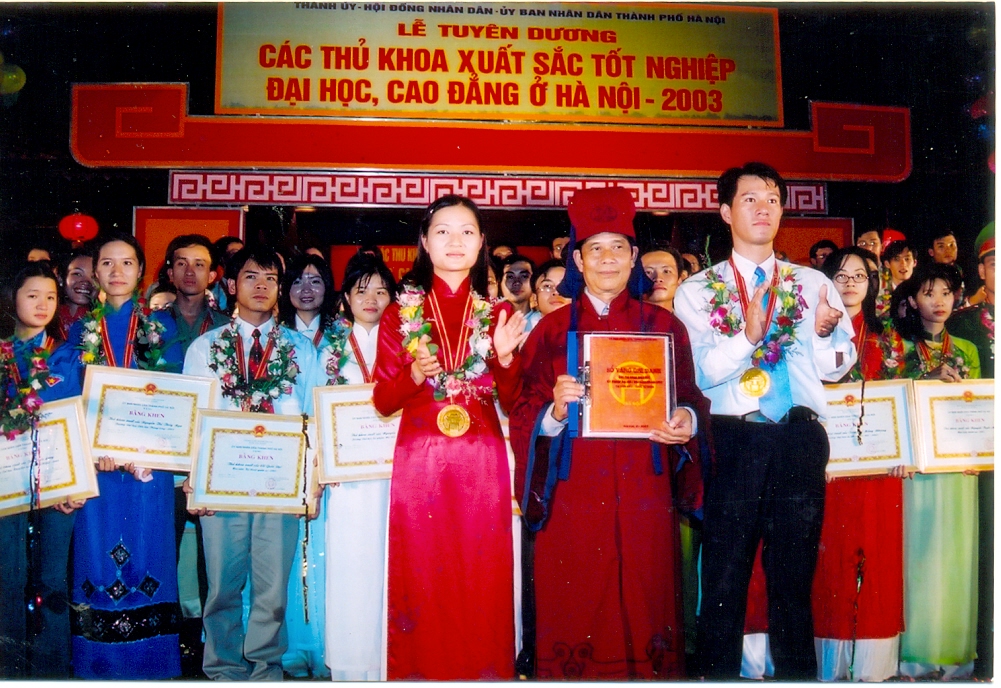
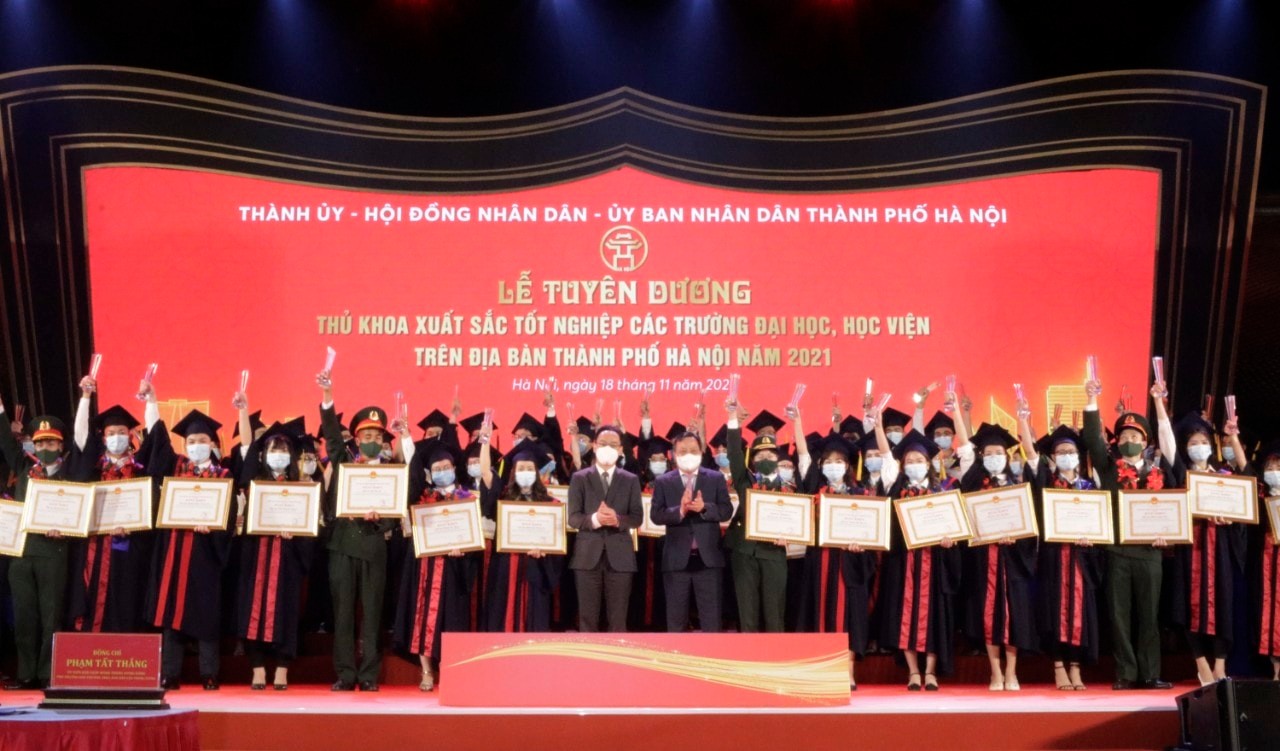
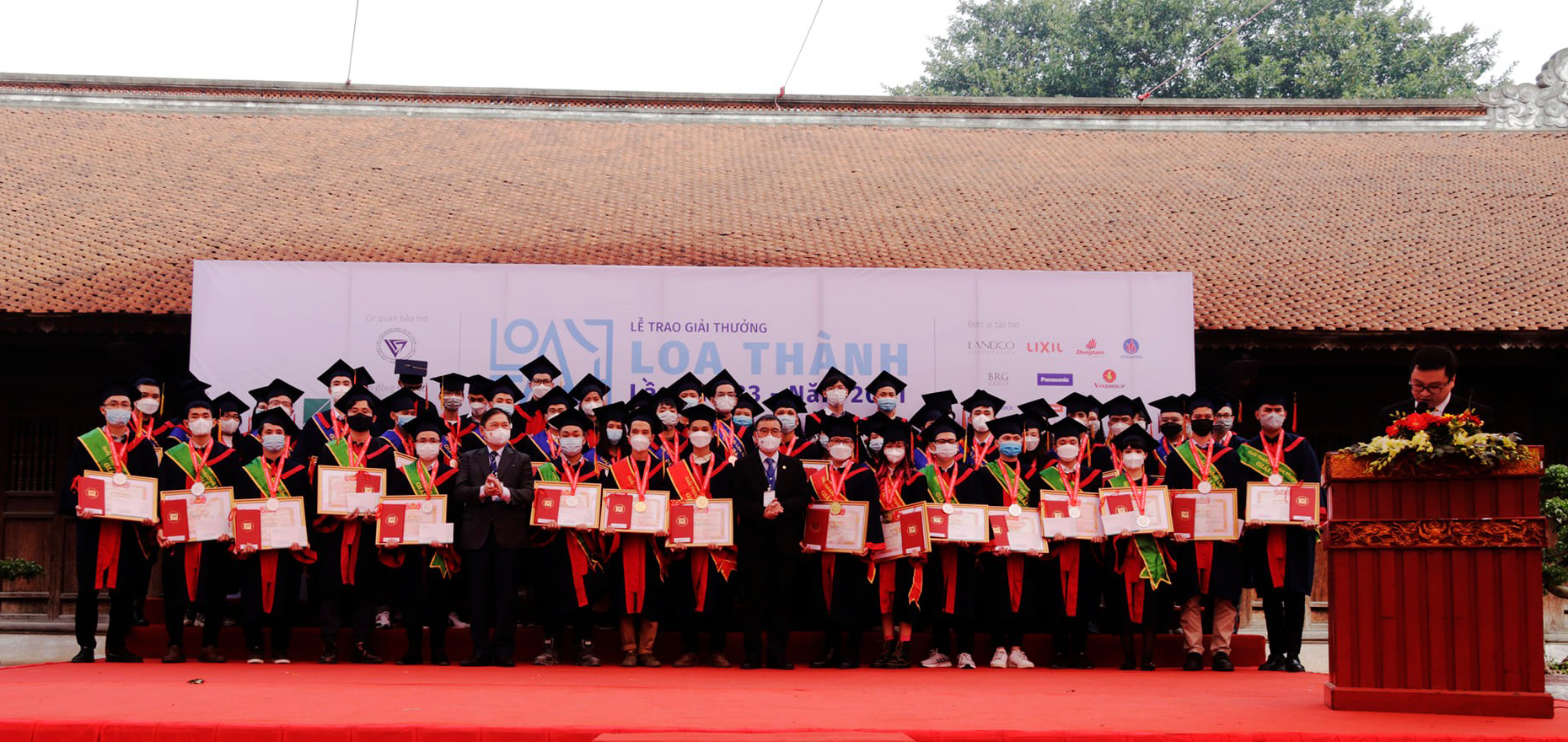
C
BP
THE QUỐC TỬ GIÁM IN THĂNG LONG- A PRINTING HOUSE AND PUBLISHER IN THE FEUDAL TIME
Besides educating and training talents in the capital, another important task that Quoc Tu Giam School performed is printing Confucian materials to provide teachers and students in provinces, and schools and classes throughout the country.
In the early independence period, textbooks were brought back from China; The transportation distance was very long, the cost was also expensive. The number of books was limited, which caused many difficulties for learning and teaching. By the 15th century, woodblock printing developed, the Vietnamese people could print their own books and publish books. Quoc Tu Giam School became a publisher of textbooks for teachers and students throughout the country.
Until now, when Quoc Tu Giam started printing textbooks for students is still unknown, but historical documents show that this school printed books. In 1483, when King Le Thanh Tong ordered to expand the Thai Hoc house and built the Lecture Halls, he also gave an order to build a book printing warehouse. Le Quy Don mentioned this in his book Kien Van Tieu Luc: he wrote that the warehouse of Quoc Tu Giam school had 4 compartments used to store printing boards.
Books printed by Quoc Tu Giam school included mainly books in the Four Books and Five Classics. These books were considered "model textbooks", which were used until the Confucian examination system was abolished by the Vietnamese.
Legend has it that the printing profession in Vietnam dated back to the Ly Dynasty (Buddhist scriptures, paintings, etc.) but had not really developed. Later, Mr. Luong Nhu Hoc (1420-1501) of Le Dynasty, after twice going to China as a diplomat (1443 and 1459), learned Chinese woodblock printing, then he taught the villagers of Hong Luc and Lieu Trang, Hong Lieu commune. Since then, the book printing profession in Vietnam gradually developed. King Le Thanh Tong repeatedly issued a decree to the printer of Hong Lieu village to engrave woodblocks and print books for the court. During Hong Duc's time, books were mass printed. Therefore, Hong Duc's poetry and literature were very developed and popular.
It is said in the Comple Annals of Đại Việt that: in 1467 King Le Thanh Tong "granted a printed version of the Five Classics to Quoc Tu Giam School. Thus, this shows that the court controlled the printing of textbooks to be delivered to Quoc Tu Giam school. In 1734, the court more closely controlled the printing of the textbooks, assigned the officials of the Quoc Tu Giam school to revise the content of the Five Classics based on Chinese inscriptions, and then to print the books. Once the books were printed, they were published in the country, since then buying books from China was banned.”
Under the Nguyen Dynasty, printing was again carried out in Hue - the capital. The printed boards in the North were transferred to Quoc Tu Giam in Hue. Printing boards of Quoc Tu Giam in Thang had become valuable, precious heritage.
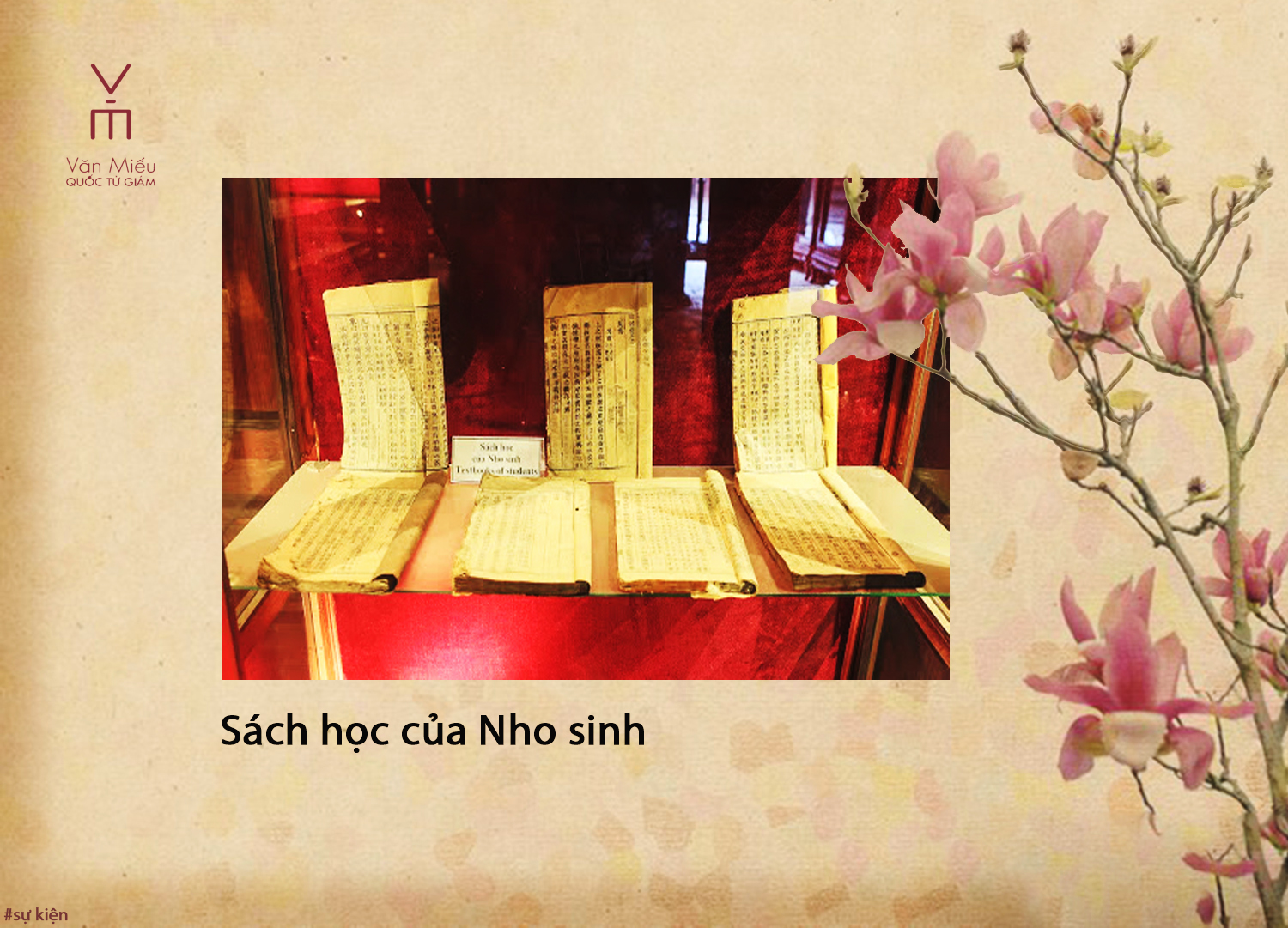
(Photo: Students' textbooks displayed at Thai Hoc house-Van Mieu-Quoc Tu Giam)
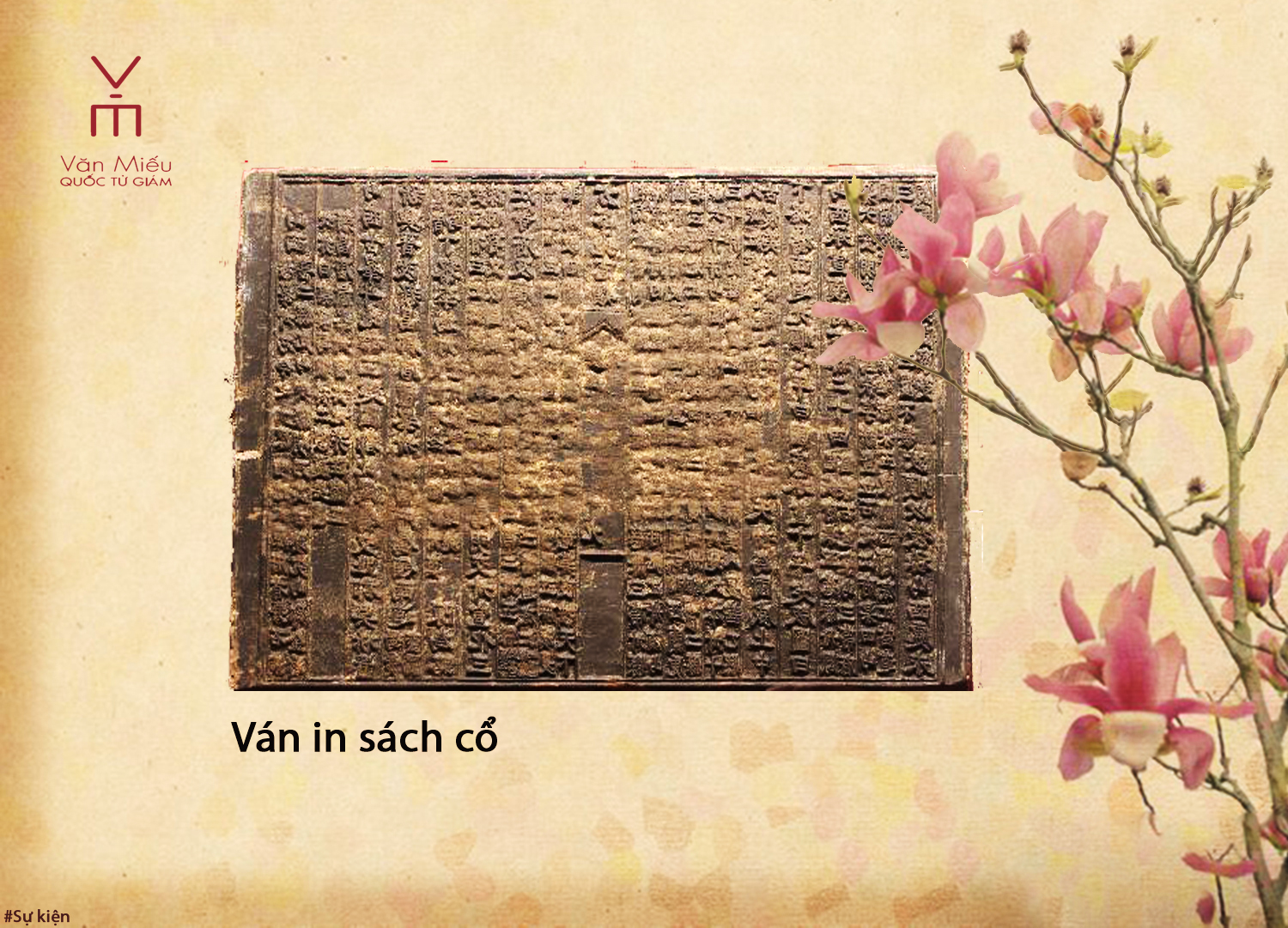
(Photo: Old book printing board displayed at Thai Hoc house, Van Mieu-Quoc Tu Giam)
CV
VĂN MIẾU-QUỐC TỬ GIÁM AND THE TRADITION OF THE FONDNESS OF STUDY
During the period of domination by Northern invaders, the classes for Vietnamese organized in pagodas attracting many people to study.
Under the reign of Lý dynasty (1009 – 1225), Lý Thánh Tông King ordered Văn Miếu to be built to dedicate Confucius and Scholars in which the king’s son came to study. In the spring of 1075, Lý Nhân Tông King, issued an edict to select Minh kinh bác học, organized the Confucianism examinations. In 1076, the king, found Quốc Tử Giám, ordered the mandarins to study. From now and then, the policy of education and examination was improved generation by generation. In the beginning of 1484, Lê Thánh Tông King ordered the stone stelae to be erected to record the names and titles of the successful scholars showing the tradition of respect for the talents and education.

Văn Miếu - Quốc Tử Giám nơi hun đúc, lưu giữ, bảo tồn và phát huy truyền thống Hiếu học quý báu của Dân tộc Việt Nam
(Ảnh: cổng Văn Miếu)
The tradition of the fondness of study of a nation has been extending widely as well as the establishment and development of education and exams and the tradition of respect for the talents and education. The small schools were opened around the nation for the common people to be virtuous and talented people.
The inscription on the stone stelae reminding the scholars the spirit of the fondness of study. The education is a foundation to be the good man to succeed.

Vườn bia Tiến sĩ - Nơi lưu danh những tấm gương hiếu học và dòng họ khoa bảng của Dân tộc
(Ảnh: Khu vườn bia Tiến sĩ, Văn Miếu – Quốc Tử Giám)
Nowadays, Văn Miếu – Quốc Tử Giám is a well - known cultural tourism location, attracting many foreign tourists as well as domestic tourists. Every years, a plenty of families and students throughout a country coming here to make offering to express their deep gratitude to the Sages and Saints. Văn Miếu – Quốc Tử Giám and 82 stone stelae that are always treasures of a nation recording the tradition of the fondness of study, the tradition of respecting the teachers and the talents.
Các em học sinh tìm hiểu về truyền thống giáo dục khoa cử Việt Nam trong chương trình Giáo dục Di sản tại Văn Miếu – Quốc Tử Giám
(Ảnh: Học sinh tại khu trưng bày giáo dục khoa cử Việt Nam, khu Thái Học, Văn Miếu – QUốc Tử Giám)
Văn Miếu – Quốc Tử Giám ngày nay luôn là niềm tự hào, điểm lựa chọn đầu tiên của các em học sinh để chụp ảnh lưu giữ những mốc học tập quan trọng
(Ảnh: Học sinh chụp ảnh lưu niệm khi tổ chức lễ tốt nghiệp THPT tại sân Thái Học, Văn Miếu – Quốc Tử Giám)
Các em học sinh cùng cha mẹ và thầy cô tham dự Lễ dâng hương và tìm hiểu về truyền thống giáo dục khoa bảng thông qua những tấm gương hiếu học của các danh nhân trên bia Tiến sĩ.
(Ảnh: Học sinh THPT tham dự khuyến học tại di tích Văn Miếu -Quốc Tử Giám)
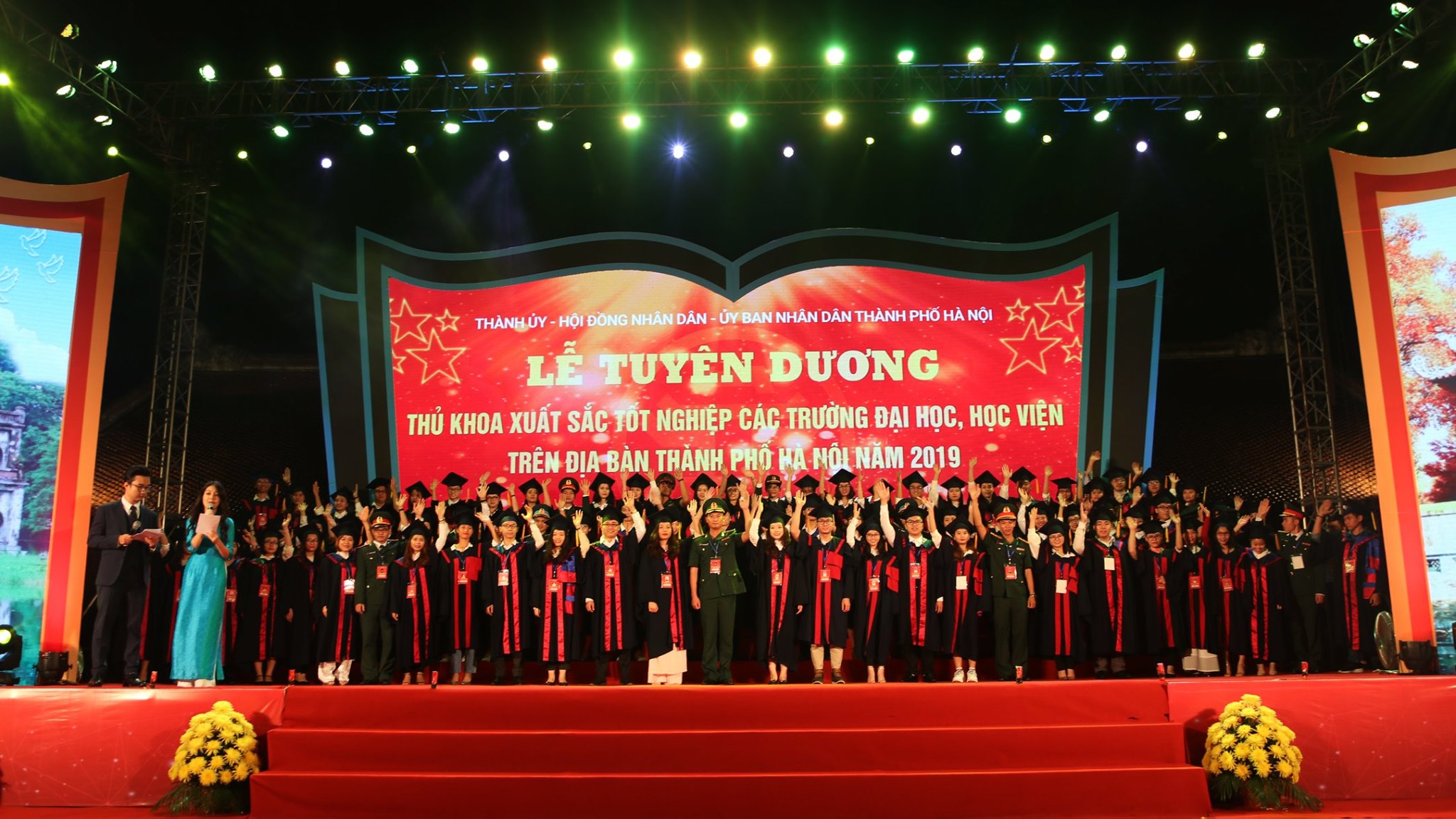
Thủ khoa các trường Đại học trên địa bàn thành phố Hà Nội rất vinh dự khi được tuyên dương tại sân Thái Học – Nơi xưa kia chính là Quốc Tử Giám (trường Đại học đầu tiên của Việt Nam)
(Ảnh: Lễ Tuyên dương thủ khoa xuất sắc tốt nghiệp các trường Đại học, Học viện trên địa bàn thành phố Hà Nội năm 2019, tổ chức tại Văn Miếu – Quốc Tử Giám)
BP
GIÁM SINH
Quốc Tử Giám was founded in 1076, under the reign of King Lý Nhân Tông, opening a cademic education in Viet Nam. Over 700 years, Quốc Tử Giám had always been the largest education center for training talented men in the nation.
Students of Quốc Tử Giám were called Giám sinh. Initially, most of the students of Quốc Tử Giám were approved by the king for admission, including civil servants, royal children, and mandarins. Under Lê dynasty, it was open to common and talented children. Normally, students who pass the Huong (Provincial) exam and pass the test of the Ministry of Rite were allowed to study at Quốc Tử Giám.
The number of students studying at the school was about 300 people, the time to study lasted from three to seven years. There were tests at the end of each month and at the end of the year. Those who passed the tests and exams of the Ministry of Rite were able to participate in the Hội (National) and Royal exams to get the title of doctorate laureate. There were also many talented and virtuous students who were appointed as mandarins by the Ministry of Rite while still studying at the school.
Teaching and learning were taken very seriously. The court issued a rule: first to teach students to be virtuous, and then to knowledge. The student who stayed out over night or was off for 1-2 days had to get permission. Those who were lazy of learning, or missed roll call for the first time would pay 140 pieces of paper as punishment; the second time they would: pay 200 ps; the 3rd time they would be given 50 lashes; and the 4th time they would be sent to Ministry of Justice for interrogation.
As a result, after more than 700 years of operation, Quốc Tử Giám had trained hundreds of talented and virtuous mandarins, many of whom were assigned to hold important responsibilities in the court. Many of them had made contributions in many fields to the country.
The number of Quốc Tử Giám’s students passing the exams was very high. The examination in 1721 had 3000 candidates, only 25 people passed, including 13 students of Quốc Tử Giám. The exam in 1739 had 3000 students participating, but only 8 people passed the exam, of which 4 were former students of Quốc Tử Giám. In particular, there was a case where both brothers were students of Quốc Tử Giám and both passed the National exam.
Quốc Tử Giám was the largest education center in Vietnam during the monarchy. Generations of students had come from here to set up a career, bringing their talents to contribute to the construction and development of the country.
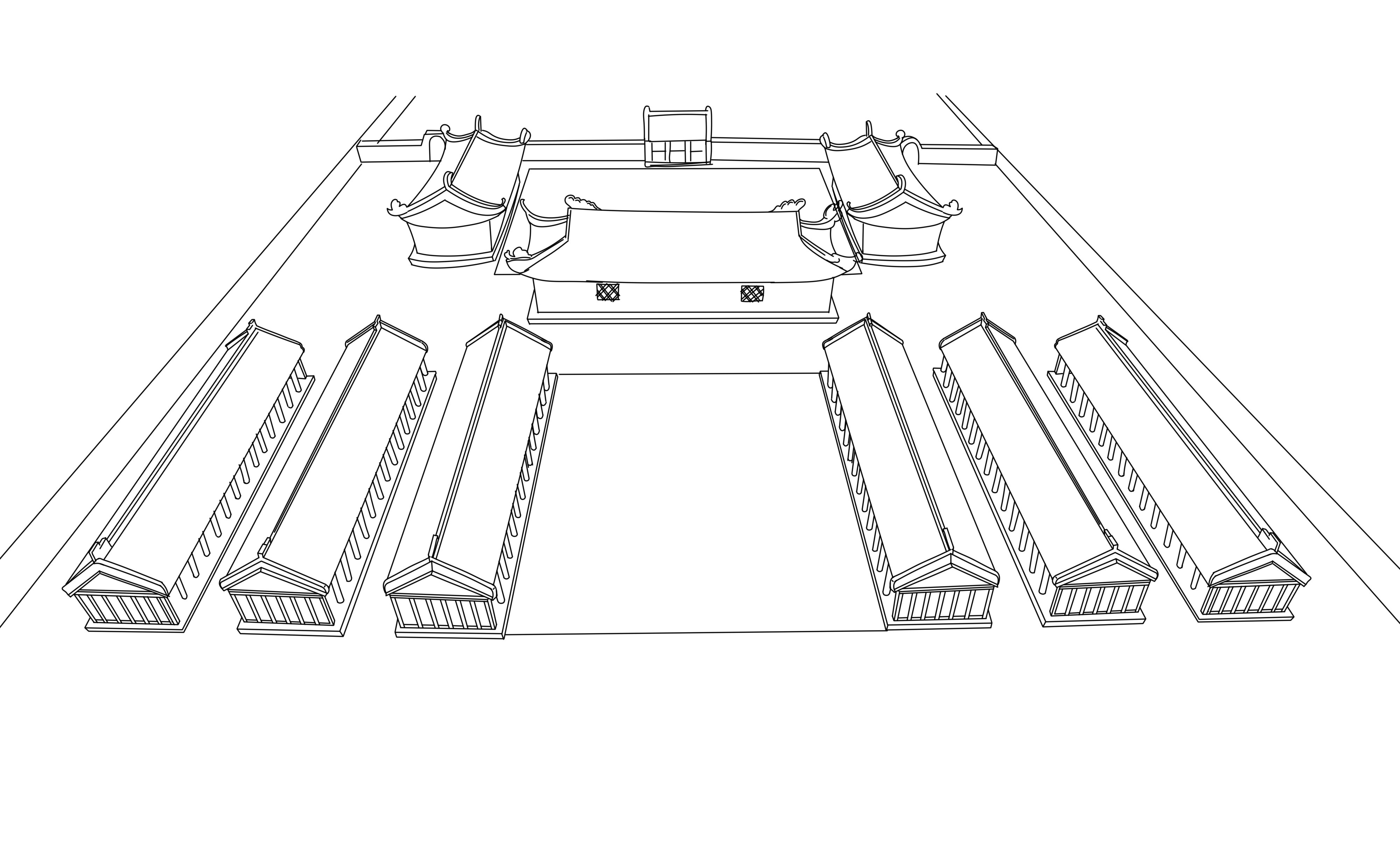
Quốc Tử Giám (Tranh minh họa)
LH
LITERARY CONFERENCES AT QUỐC TỬ GIÁM THROUGH PHẠM ĐÌNH HỔ'S HISTORICAL RECORD IN “VŨ TRUNG TÙY BÚT”
Quốc Tử Giám was the biggest examination center in Vietnam since 1076. The official students of Quốc Tử Giám were among many who came to join the literary conferences at Quốc Tử Giám.In the beginning of 18th century, the literary conference held at Giám building twice a month, organized by a solemn national procession. The well-known government officials with their wide knowledge invited to be present at literary conferences. The select top essays represented by theirs own authors. Listeners could see the features of each literary work from the different voices of authors.The topic of final exam given by King concerning the contemporary problems, held at the King's court. The examinees must have deep understanding beyond the rules to do a perfect essay.
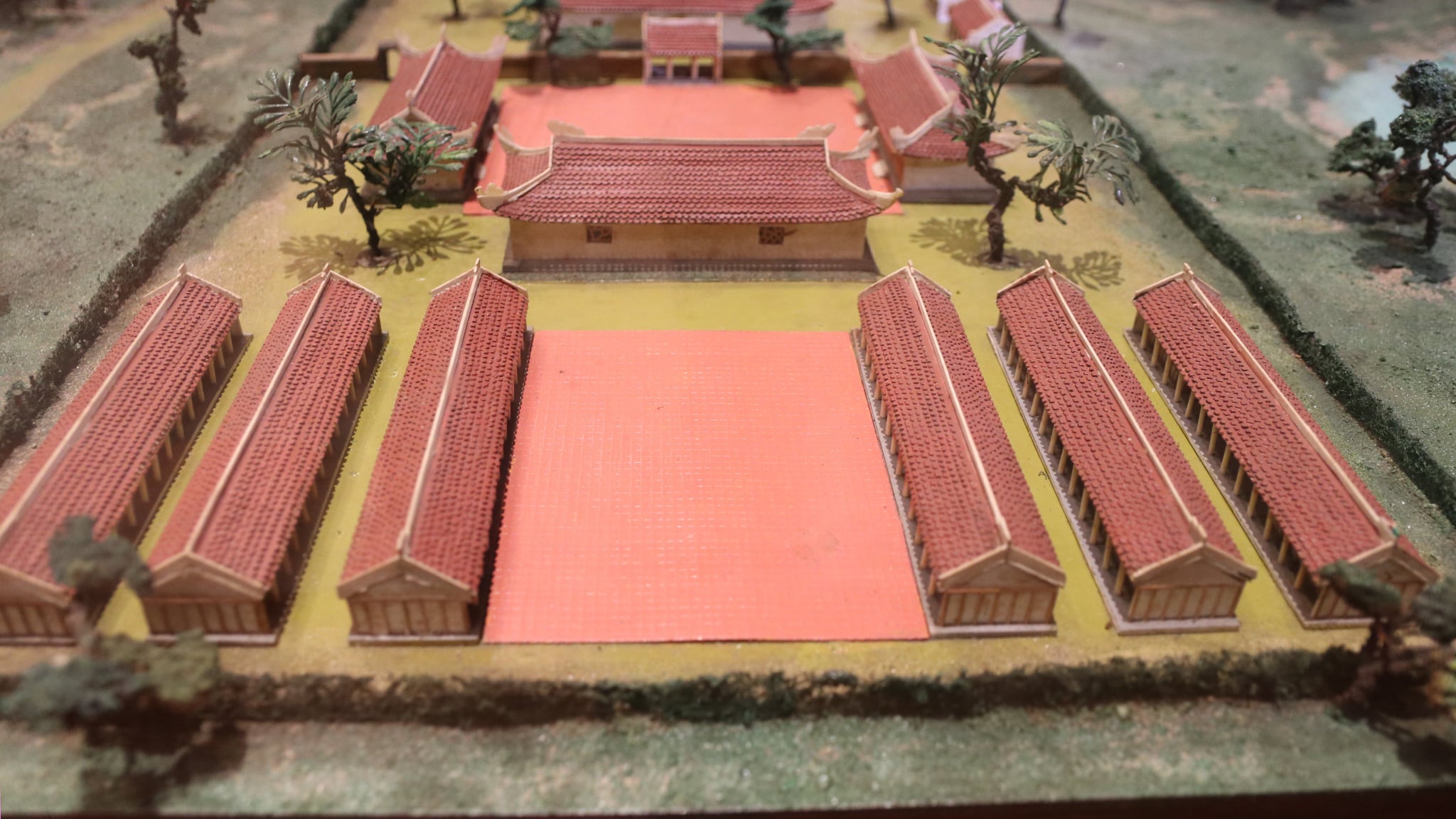
The lay-out of Quốc Tử Giám under Lê dynasty
Participating in literary conferences was a good opportunity to train and raise the creation of literary works for offical students of Quốc Tử Giám as well as common students from the outside. They could learn from the comments and compliments and criticalnesses to improve their levels. The literary conferences at the first national university was attractive activities, expected by all of students throughout a nation.
Translator::BBP
BÁI ĐƯỜNG - HOUSE OF CEREMONY
Đại Thành sanctury section is where annual ceremonies honoured Confucius took place on the first Đinh day of the second and 8th lunar months. Usually, the king was himself the chief of the ceremony organising board, rarely, he appointed his family member, or high rank mandarin as the chief instead. Under Trần dynasty it is also used to honor Chu Văn An - Tư nghiệp of Quốc Tử Giám here.
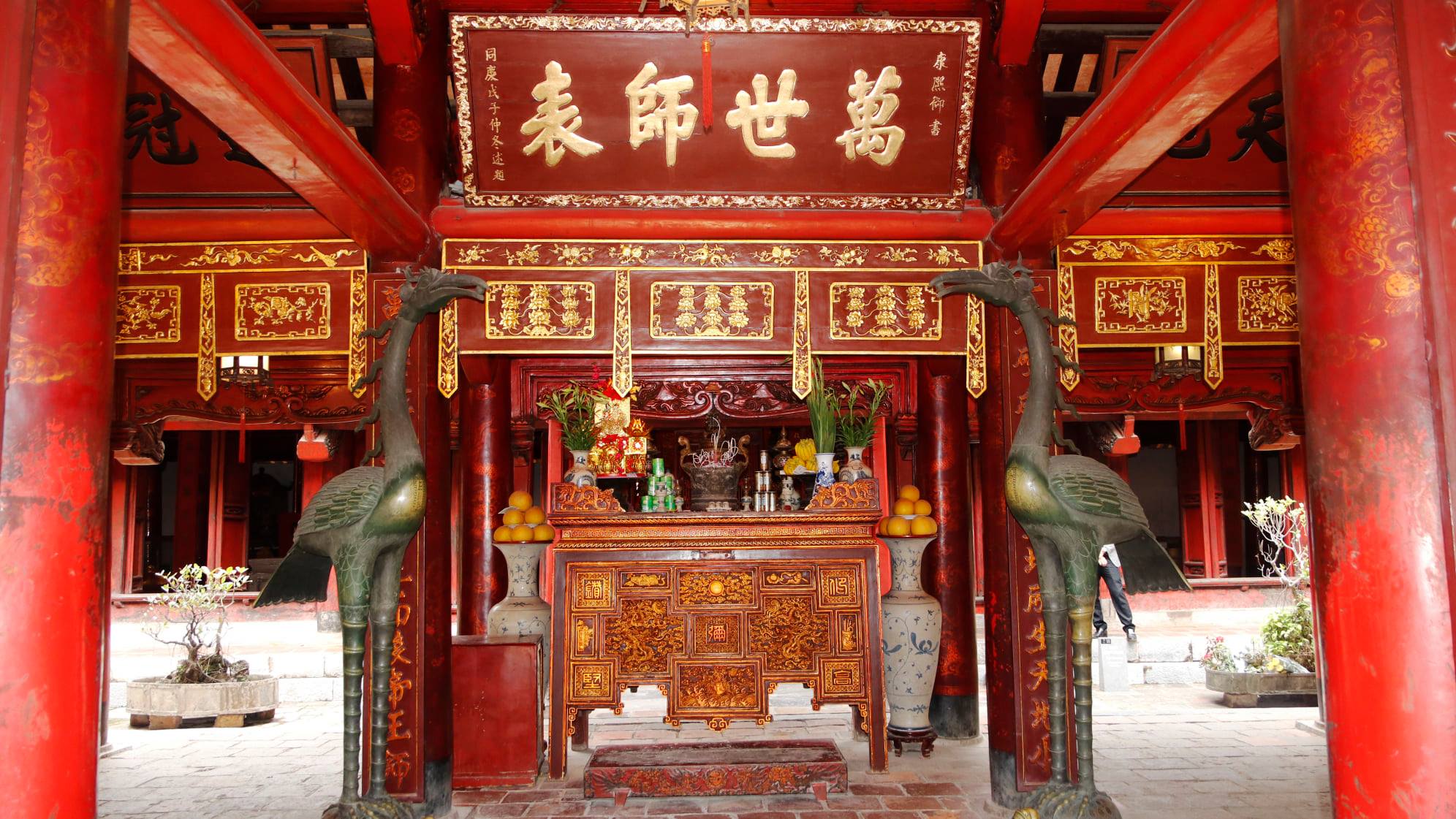
Bái Đường (House of ceremony) roofed with shoe toe shape tiles. On top there are two dragon flanking the moon. In the center of Bái Đường there is the shrine with worshiping items on top. The shrine is the place where kings and high ranking mandarins – the heads of the ceremony offered sacrifices to Confucius in ceremony time. Above the shrine is the horisontal board with 4 Chinese characters in capital: Vạn thế sư biểu (the everlasting exemplary educator), made in 1888. The characters were the copy of handwritting of Chinese King Kangzi (1662-1722) honouring Confucius. There are here many horisontal boards with characters and couples of sentences praising Confucius. Of particular are a horisontal board with 4 Chinese charaters: Cổ kim nhật nguyệt (like the sun and the moom, though time: past and present) and the great bell Bích Ung made by Quốc Tử Giám concurent Nguyễn Nghiễm in 1768.
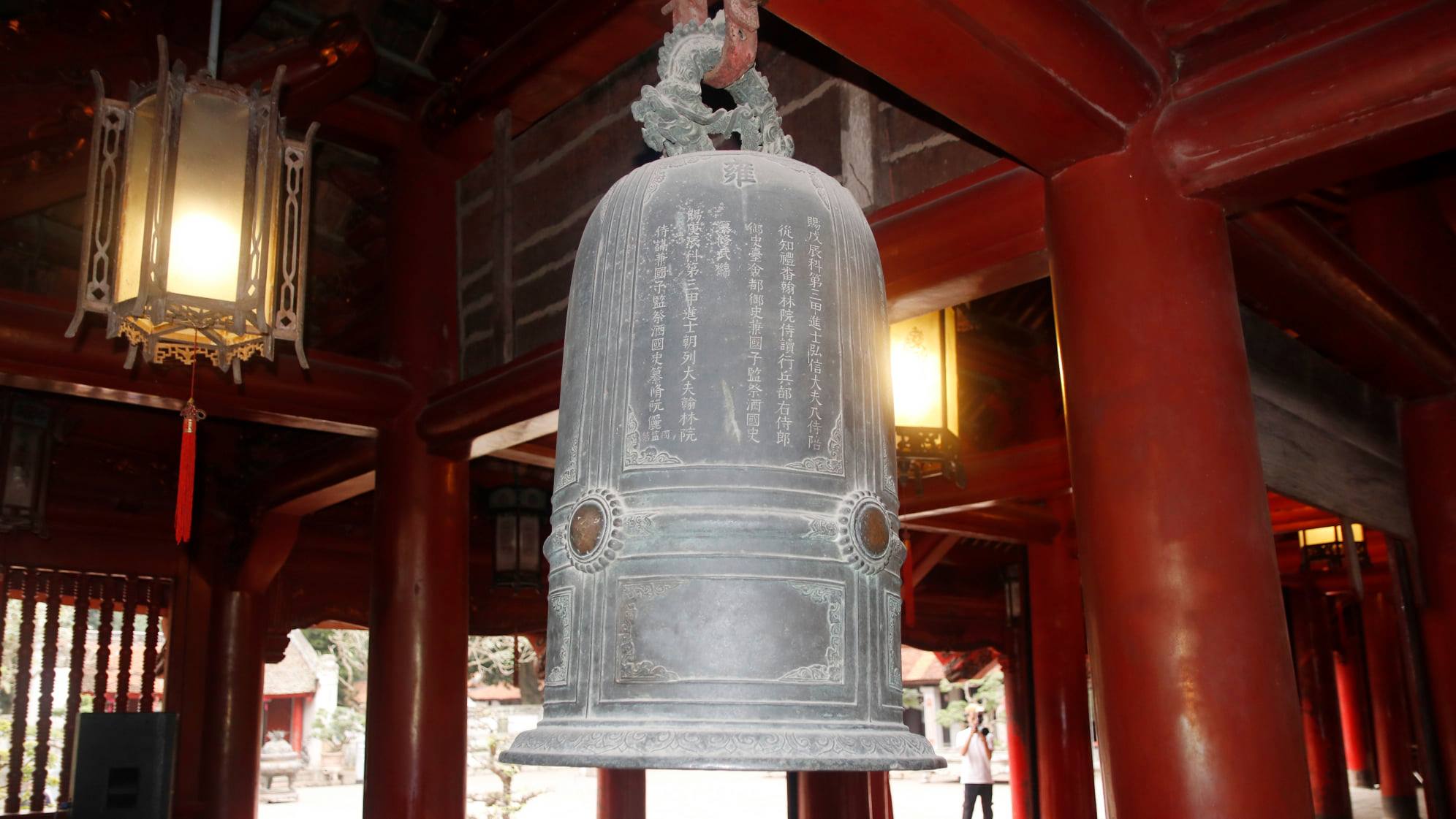
ĐẠI THÀNH GATE
Đại Thành Gate is in the architectural style of the Later Le dynasty (15th -17th centuries). It is a wooden structure with three compartments and a shoe-shaped tiled roof. The doors are decorated with motifs of “dragons in clouds”, depicting the aspiration for a prosperous system of education.
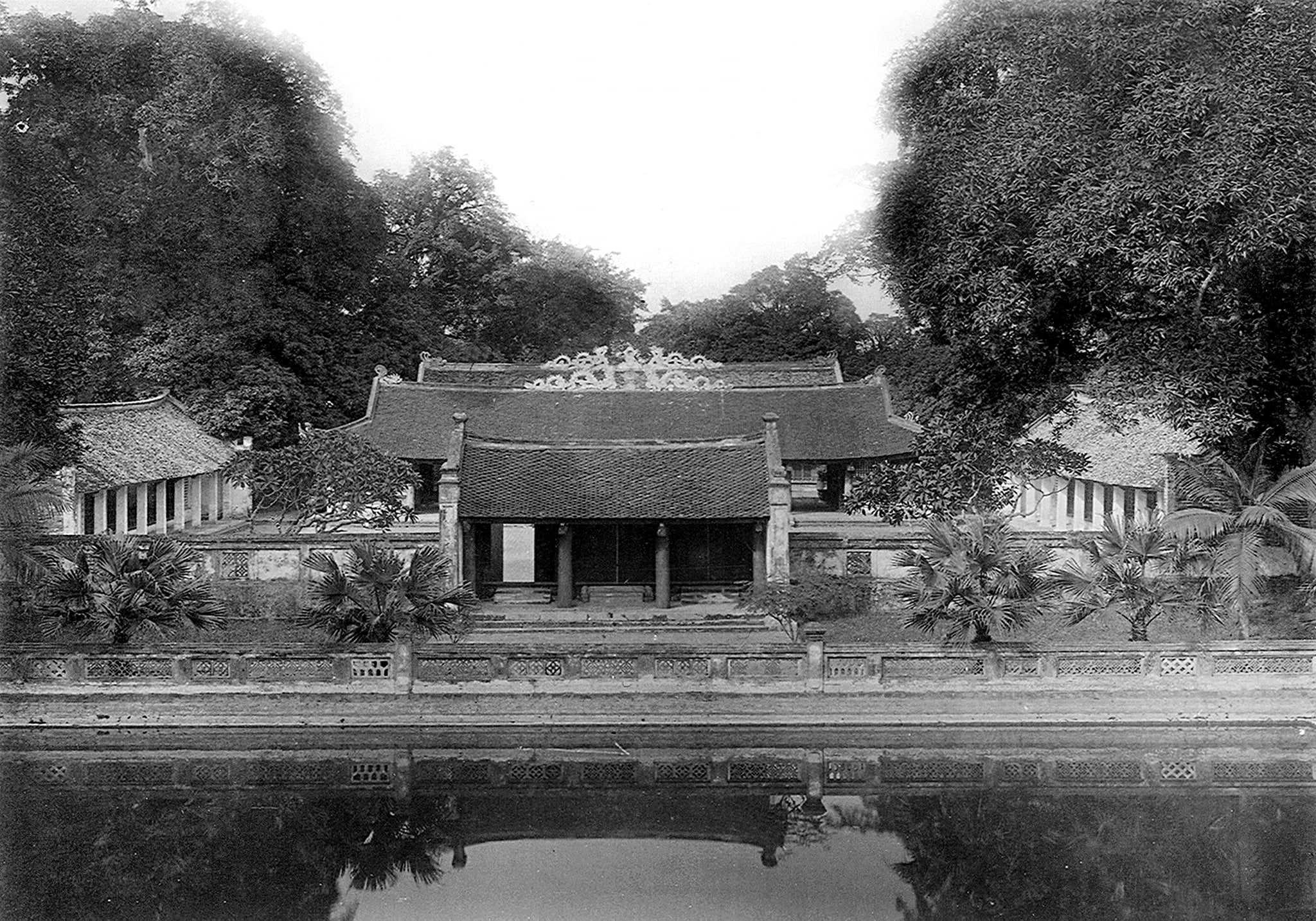
There is in Đại Thành gate a horizontal board with Chinese characters “Đại Thành Gate”, where on the right side are small characters “in the 8th lunar month, Autumn, in the year Canh Tuất, the 2nd year of reign title Thần Vũ of King Lý Thánh Tông (1070), was built by the King order”, on the left side: “In the middle of winter, in the Mậu Tý year, the third year of Đồng Khánh reign title (1888) was restored”. This board reconfirmed the date of construction of the Văn Miếu: 1070.
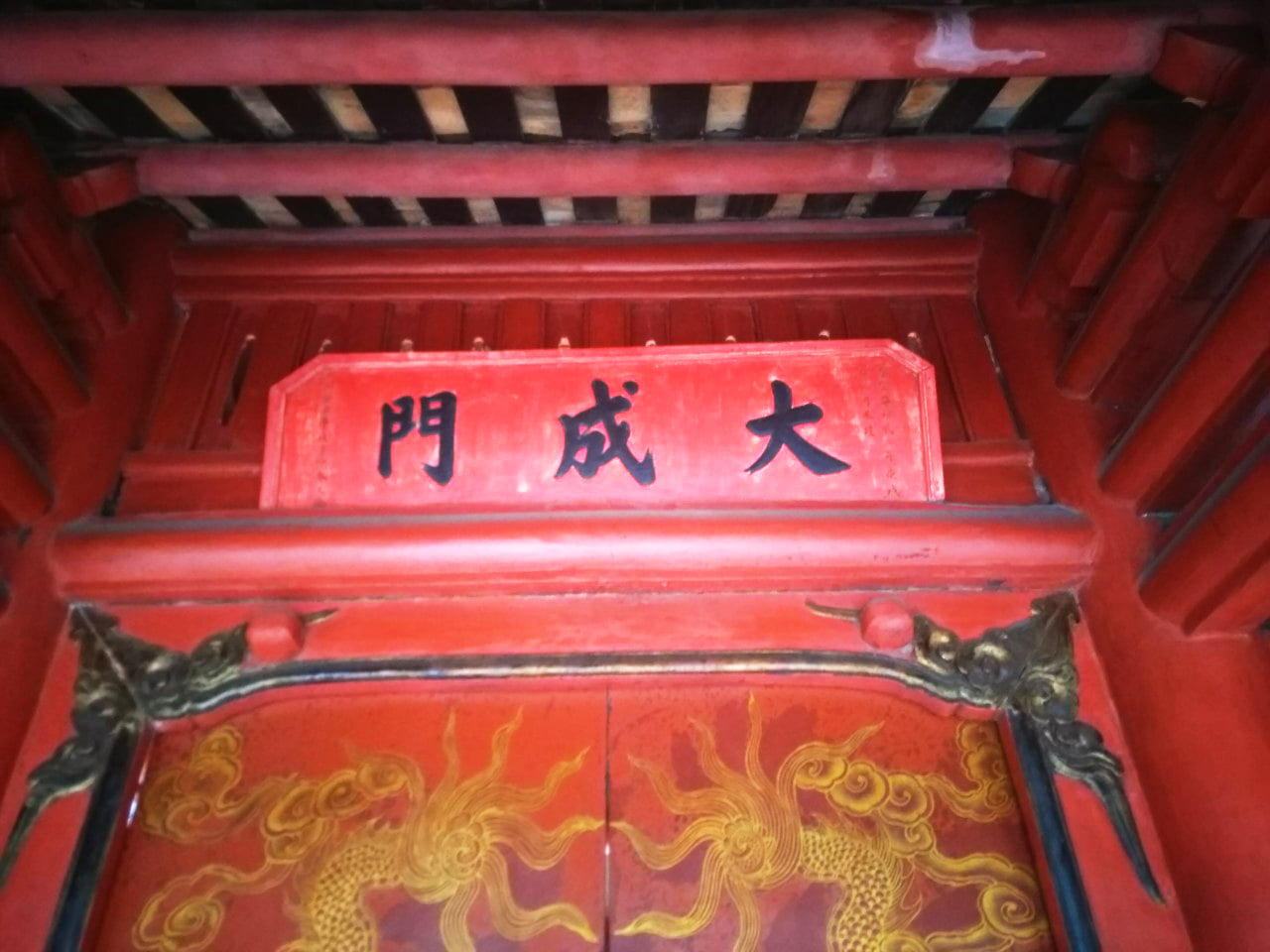
On the platform of Đại Thành Gate are six mythical and sacred creature – Nghê (two stone and four wooden) which are used as doorhinges.
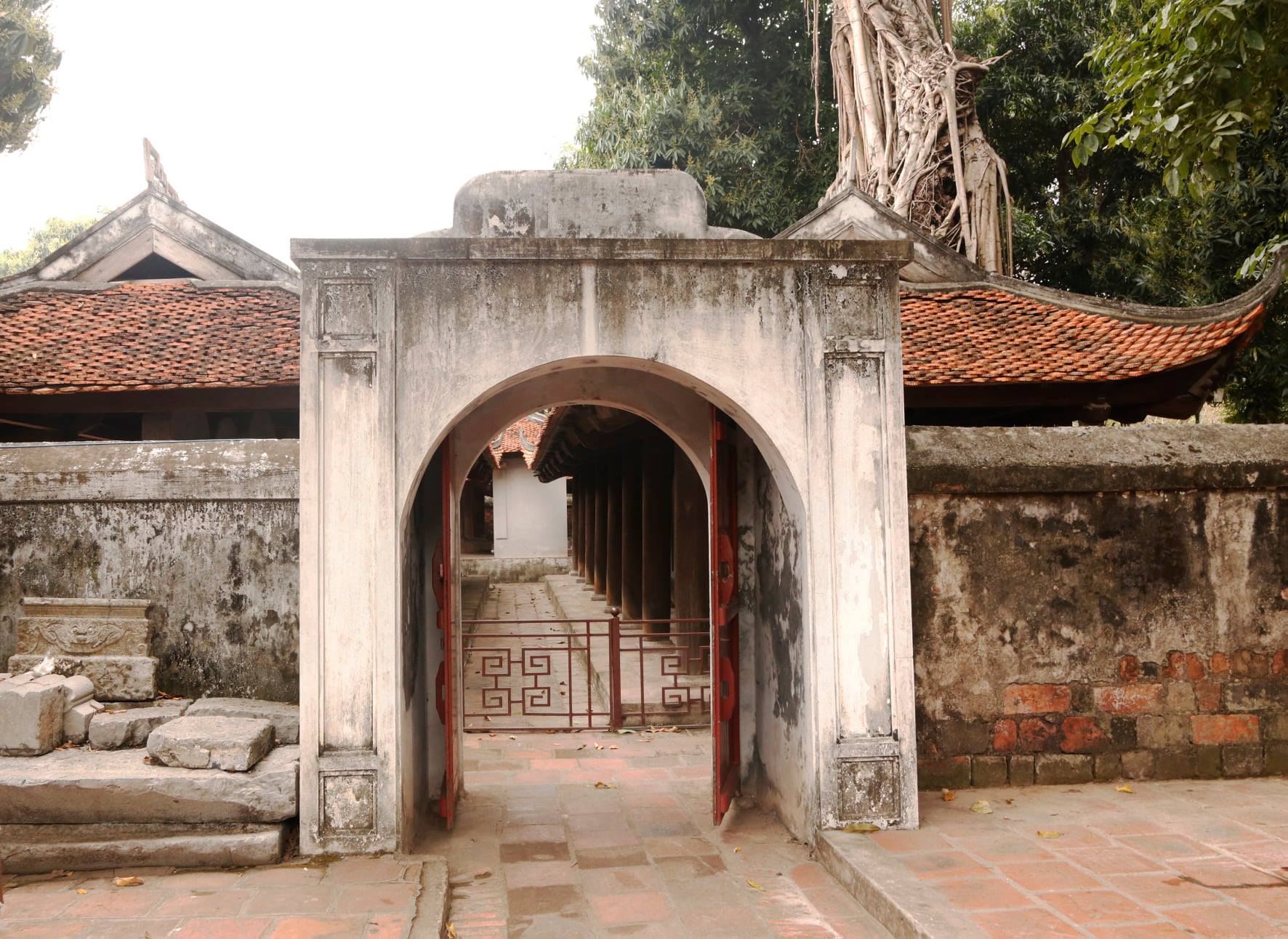
Kim Thanh Gate
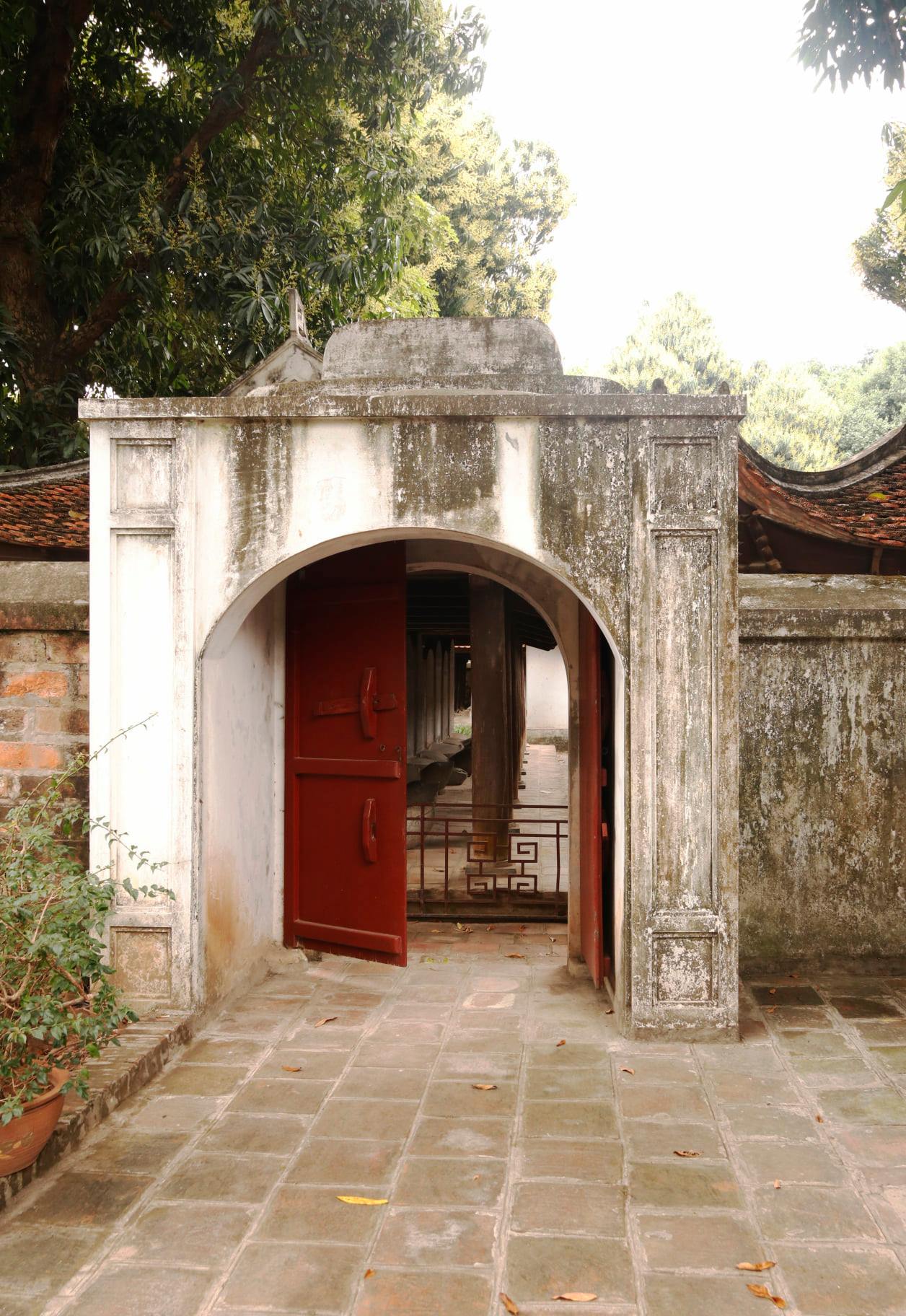
Ngọc Chấn Gate
To the sides of Đại Thành Gate are two small side gates, Kim Thanh (Golden Sound) and Ngọc Chấn (Jade Vibration)
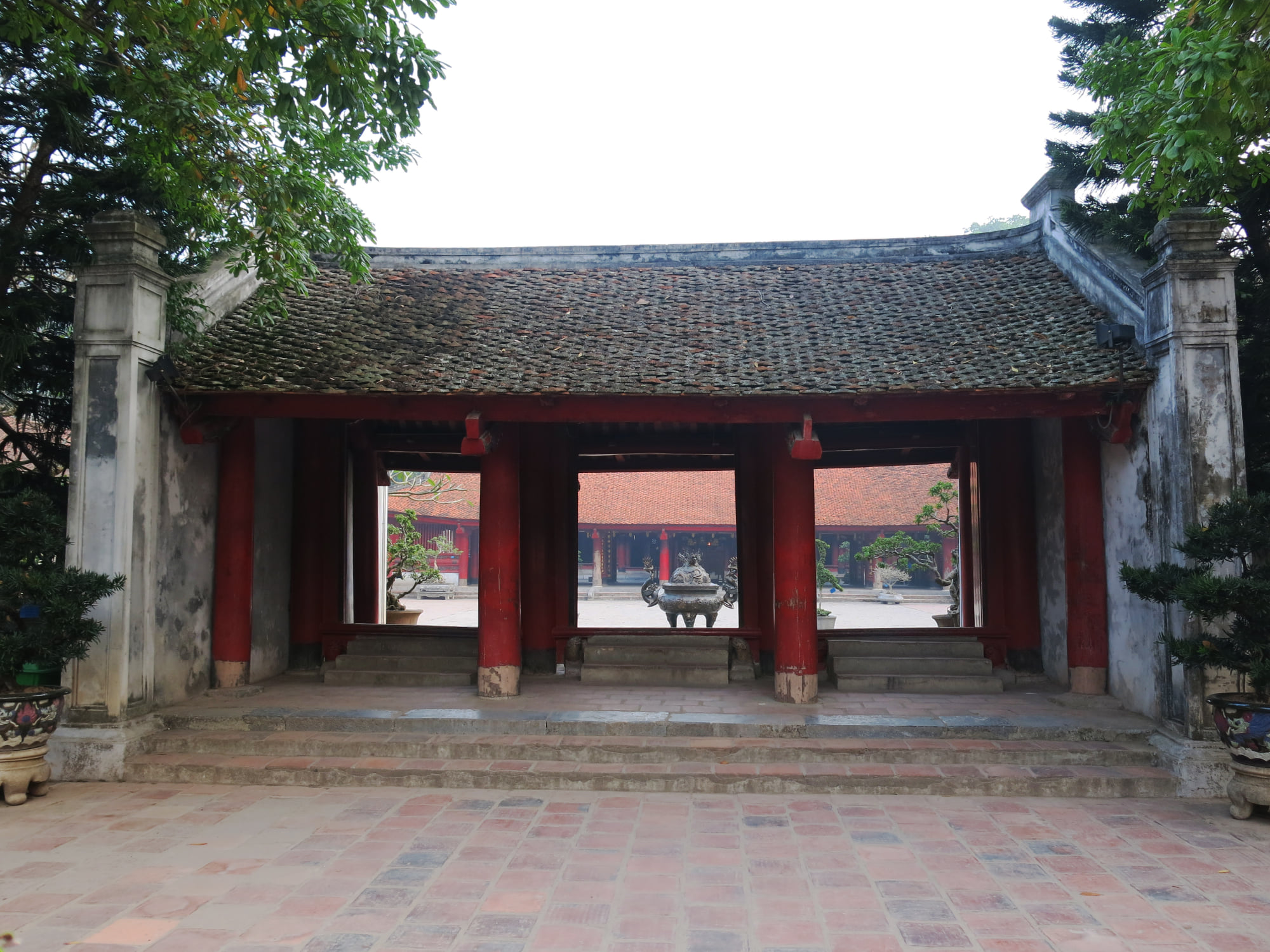
POETRY PRAISING DOCTOR'S STELE IN VĂN MIẾU
Visiting Văn Miếu-Quốc Tử Giám today visitors can read a poem written by Lord Trinh Can when he visited here in November 1695. This poem was engraved on a wooden letter board hanging at the Bái Đường (Ceremony) building of the Special National Landmark of Văn Miếu-Quốc Tử Giám.
Lord Trinh Can was very interested in the development of culture, education, and respect for talents. On the occasion of a visit to Văn Miếu – Quốc Tử Giám, he wrote a poem to praise this place which was the centre of education. The poem also praised the talent whose names were engraved on the Doctor's stele everlasting with heaven and earth.
The poem also shows that Văn Miếu – Quốc Tử Giám had always been in the interest of and respected by the state since it was established under the Ly dynasty (11 century) to the Le dynasty (18 century). Văn Miếu – Quốc Tử Giám recorded the periods of the educational development of Đại Việt nation.
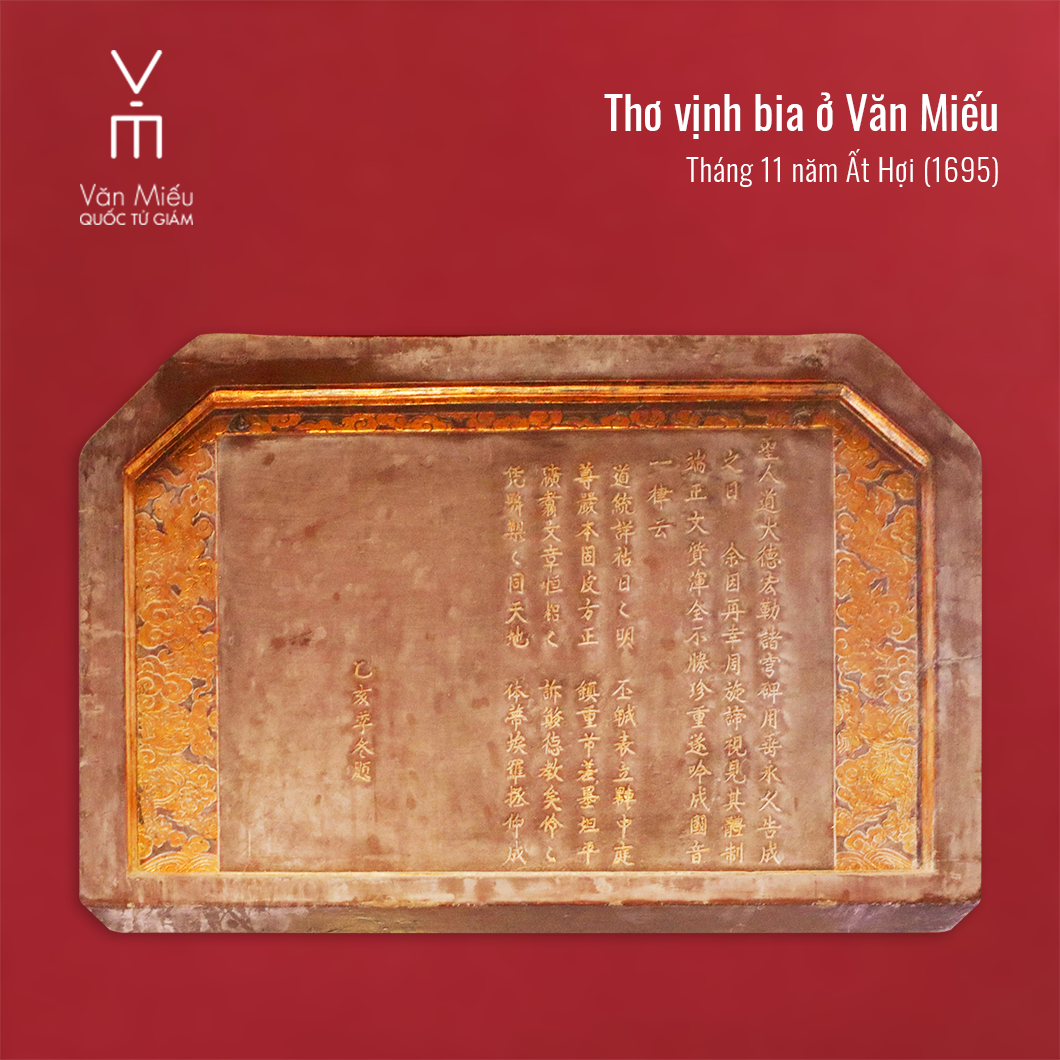
LH
TEACHERS OF QUOC TU GIAM
Quoc Tu Giam was the national school at the imperial capital. For over 700 years, the goal of the teaching and learning was to train the virtuous and talented people to serve the country. Great efforts were made in honing and building talents at Quoc Tu Giam. They were great and moral teachers entrusted by the court to carry out this admirable responsibility.
The dynasties in history were always interested in recruiting talented, high-quality, virtuous teachers for Quoc Tu Giam to take charge of management, administration and teaching at the most important educational center of the country.
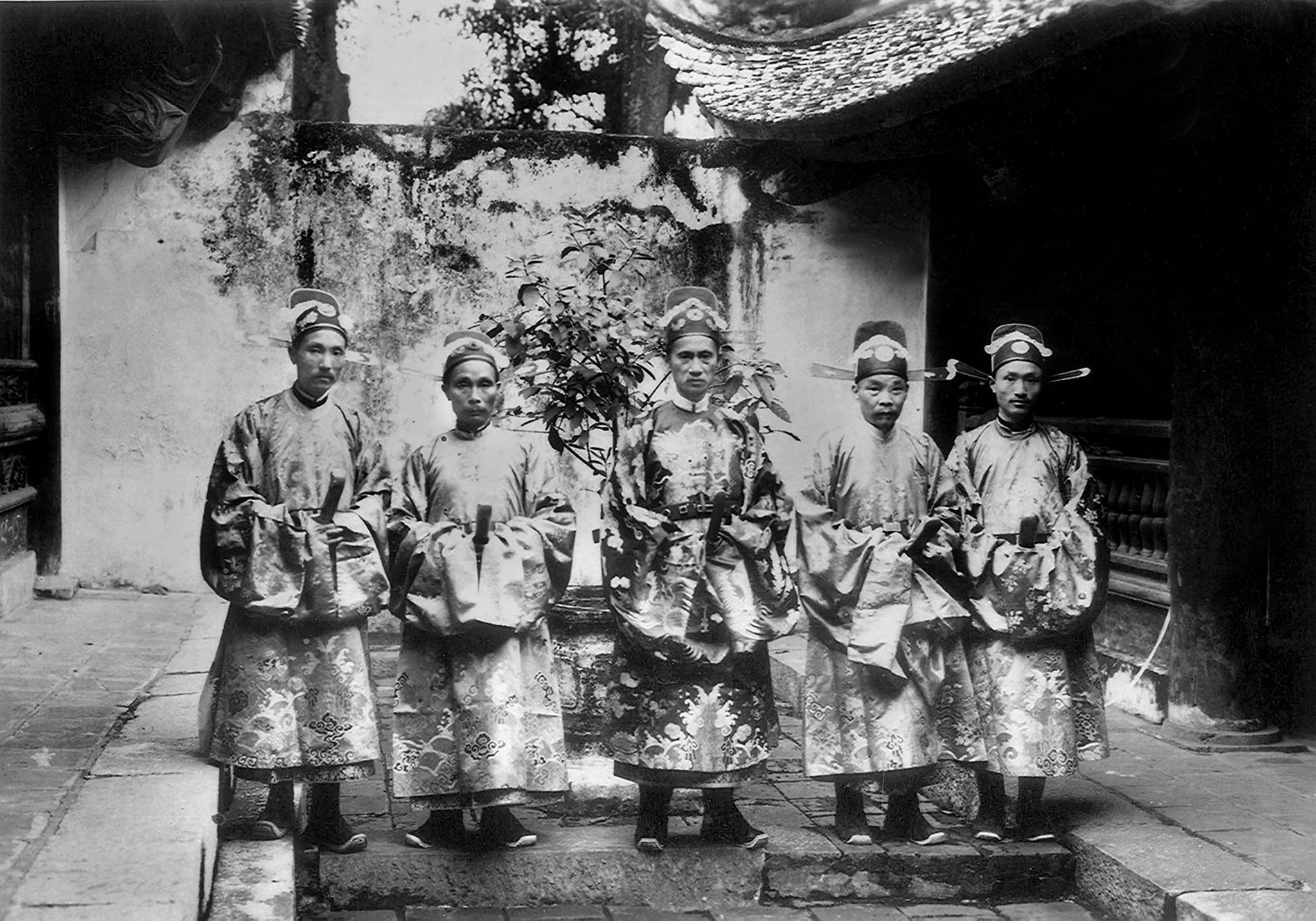
Offcials of Quoc Tu Giam school
Under Ly Dynasty, there was no record of the teachers at Quoc Tu Giam. Under Tran Dynasty, the head of Quoc Tu Giam was Tu Nghiep (Principal). The most famous principal of the Quoc Tu Giam was Chu Van An (1292 - 1370), who was invited by King Tran Minh Tong to become Principal. He was a typical teacher in Vietnam's educational history. In addition to respsected Principals there were also teachers, such as Doan Xuan Loi, who passed the exam in 1384.
During the Le Dynasty, the dynasty recruited a large number of mandarins to meet the teaching requirements at Quoc Tu Giam. The prnicipal of Quoc Tu Giam was called Te Tuu and the vice principal was Tu Nghiep. The responsibility of Te Tuu was to manage the Temple of Literature, training student, monthly according to the periodTEACHERS OF QUOC TU GIAM guided the students to write in order to build talents to help the country”. In addition to being a Principal of Quoc Tu Giam, Te Tuu was also responsible for supervising the Temple of Literature, and implementing the ceremony of spring and autumn at the Temple of Literature.
The Imperial Court stipulated that those who hold the position of Te Tuu (Principal) and Tu Nghiep (Vice – Principal) must pass the royal exam, and hold important duties of the court. From 1721, King Le Du Tong ordered Te Tuu to join in teaching students at Quoc Tu Giam, to encourage students, improve the quality of education, organize examinations students' progress, marking papers and reporting to the Ministry of Interior Affair for recruiting talents according to regulations.
The Principal and Vice Principal of Quoc Tu Giam were not only the managers of education, but also cultural men of the nation. Under Le Dynasty, the teachers of Quoc Tu Giam were carefully selected by the court. The teachers had been in charge of teaching at Quoc Tu Giam, contributing to training talented people for the country. They were all well-educated teachers, experienced in education, had clear ethics, were examples of character, intellect not only for students, but also typical among contemporary scholars.
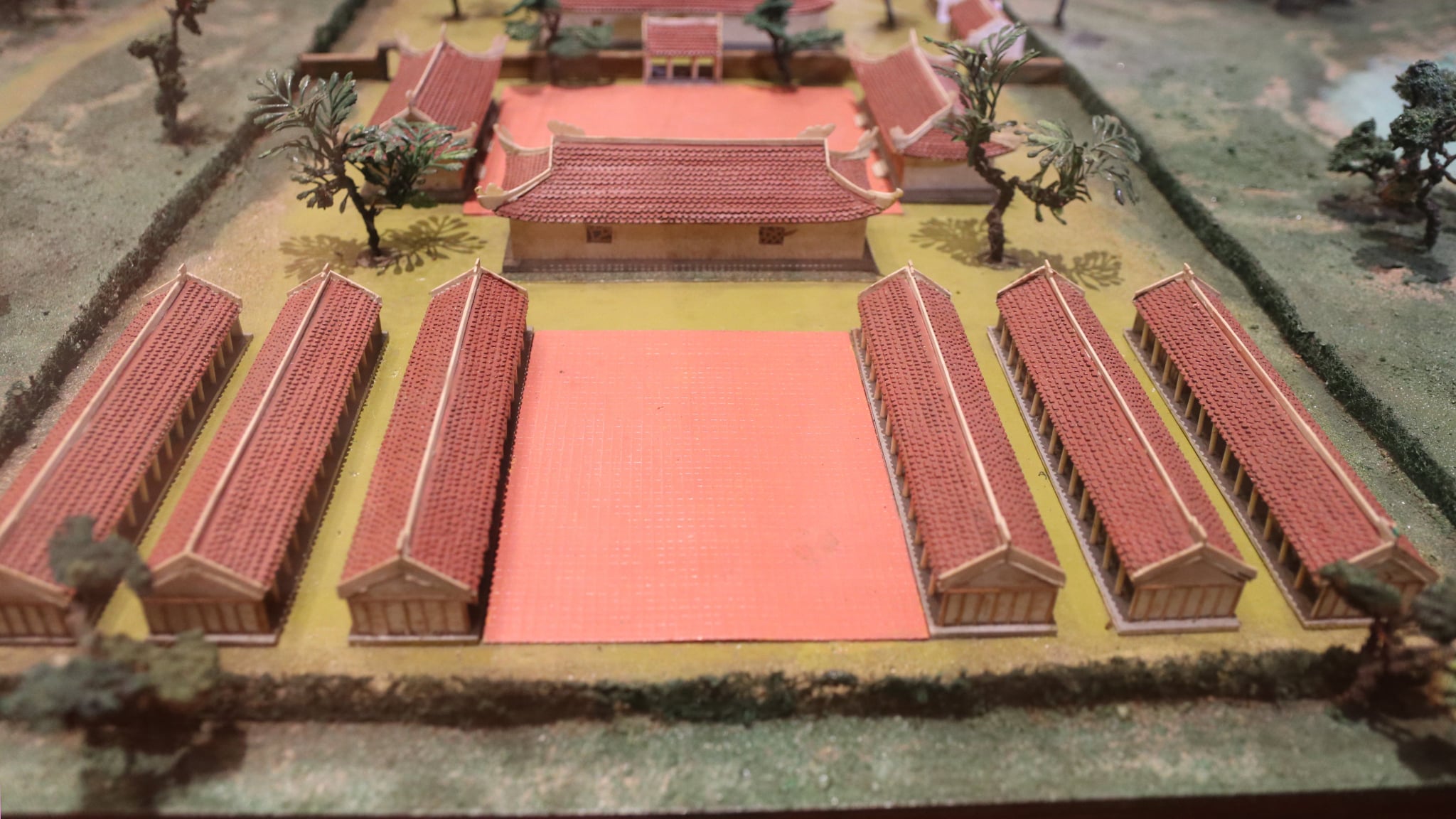
An architectural model that shows Quoc Tu Giam school in the Lê dynasty
The Principals, Vice Principals and the teachers of Quoc Tu Giam were examples of wisdom, talent, ethical models, dedication to the education of the country.
LH
The principals and vice principals of Quốc Tử Giám school in Thăng Long and the Cultural and Educational Development of the Nation.
For more than 700 years, from the 11th century to the end of the 18th century, Quốc Tử Giám school in Thăng Long trained and recommended a number of officials and intellectuals(to the Court), which contributed positively to the development of country. The top officials of Quốc Tử Giám school like Principals and Vice Principals were all talented intellectuals who were selected from a number of prestigious scholars and Court officials.
According to statistics taken from historical documents and nomination certificates, inscriptions of stone steles in some academic localities, among 101 principals and vice principals of Quốc Tử Giám school in Thăng Long (from the 14th century to the 18th century), there are still 5 whose identities have been unidentified. In particular, most of them used to hold important positions in the Court.
As the leaders of the nation’s largest educational centre, they also held important posts in the Court. Principals and vice principals of Quốc Tử Giám school made important contributions to the cultural and educational development of the Nation. They acted as advisors to help kings use the quintessence of Confucianism in order to formulate a policy of training, development and appreciation of the country's talents. Besides, they also directly monitored the implementation of those policies.
The reality shows us that, under the leadership of the Principals and Vice Principals, Quốc Tử Giám school was highly developed and became a model school in the Confucian education system of the country. For more than 7 centuries, since the foundation of Quốc Tử Giám school in 1076, a large number of schools were established from the central to local areas, from Thăng Long citadel to provinces, districts and villages. Therefore, the schools trained thousands of talents who made great contributions in the fields of politics, economics, education, literature, history, geography, math ...
As diplomats, principals and vice principals of the Quoc Tu Giam school were sent to China (under the Ming and Qing dynasties). They managed to use their ability and knowledge to build a flexible diplomatic relationship on the principle of maintaining national independence and sovereignty.
Above all, the Principals and Vice Principals of Quốc Tử Giám School were not only "important figures" who decided the fate of the school over a period of hundreds of years under the Ly, Tran, Le dynasties; moreover, they also played an important role in promoting the overall development of the country's culture and education.
Writer: MA. Đỗ Thị Tám, Deputy Director of the Center for Scientific and Cultural Activities, Văn Miếu-Quốc Tử Giám.
Translator: CT
QUAN TẾ TỬU, TƯ NGHIỆP QUỐC TỬ GIÁM
Được thành lập từ thế kỷ XI, Văn Miếu - Quốc Tử Giám Thăng Long đóng vai trò là cơ quan quản lý giáo dục của quốc gia, là trường Quốc học cấp cao nhất của nhà nước quân chủ, nơi đào tạo ra hàng ngàn Nho sĩ, trí thức và quan lại cao cấp đáp ứng yêu cầu xây dựng và phát triển đất nước dưới thời quân chủ. Tế tửu, Tư nghiệp - Các vị quan đứng đầu, quản lý Quốc Tử Giám là những “người tài giỏi, có đức, thông hiểu kinh sách… phụng mệnh (nhà Vua) trông coi nhà Văn Miếu, rèn tập sĩ tử, phải chiếu theo chỉ truyền, hằng tháng theo đúng kỳ cho (học trò trường Giám) tập làm văn, để gây dựng nhân tài, giúp việc thực dụng cho nước”.
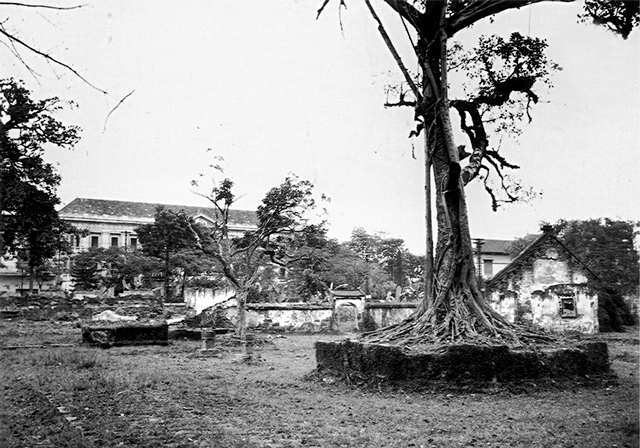
Mặc dù được khởi lập và hoạt động từ năm 1076, nhưng phải đến thời Trần (1225-1400), Quốc Tử Giám Thăng Long mới được nhà nước chú trọng phát triển cả về quy mô và cơ cấu tổ chức. Để việc dạy và học tại Quốc Tử Giám được quy củ, năm Thiên Ứng Chính Bình thứ 5 (1236) Vua Trần Thái Tông đã chọn người quản lý Quốc Tử Giám với chức vụ là Đề điệu. Tuy nhiên, phải đến năm Nhâm Thân, niên hiệu Thiệu Long thứ 15 (1272), Vua Trần Thái Tông mới đặt học quan chính thức cho trường Quốc Tử Giám. Sách Đại Việt sử ký toàn thư chép: Mùa đông tháng 10. Chọn người tài giỏi, có đức, thông hiểu kinh sách bổ làm Tư nghiệp Quốc Tử Giám. Như vậy, Tư nghiệp thời Trần là học quan chính thức của Quốc Tử Giám.
Bộ máy quản lý việc dạy và học ở Quốc Tử Giám thời Trần sau đó hầu như không thay đổi. Sang thời Lê, cùng với sự phát triển của Quốc Tử Giám, hệ thống quan chức của Quốc Tử Giám ngày càng được hoàn thiện. Năm Giáp Dần niên hiệu Thiệu Bình thứ 1 (1434), Lê Thái Tông đặt chức quan Tế tửu đứng đầu Quốc Tử Giám. Chức quan Tư nghiệp đứng thứ 2 sau Tế tửu. Ngoài ra, học quan của Quốc Tử Giám còn có Giáo thụ, Trợ giáo, Ngũ kinh Bác sĩ....
Chức Tế tửu ở Trung Quốc xuất hiện từ thời nhà Hán. Theo sách Từ nguyên của Trung Quốc, Tế tửu vốn là danh hiệu để chỉ người lớn tuổi nhất, có địa vị cao nhất trong buổi tiệc được chọn làm người dâng rượu tế đất trước khi uống. Về sau, lấy đó đặt chức quan. Tế tửu Quốc Tử Giám ở Việt Nam là chức quan đứng đầu trường Quốc Tử Giám. Theo Quan chế thời Hồng Đức, Tế tửu thuộc hàm Tòng tứ phẩm. Chức trách của Tế tửu được Phan Huy Chú cho biết trong Lịch triều Hiến chương loại chí là: “phụng mệnh trông coi nhà Văn Miếu, rèn tập sĩ tử, phải chiếu theo chỉ truyền, hằng tháng theo đúng kỳ cho (học trò trường Giám) tập làm văn, để gây dựng nhân tài, giúp việc thực dụng cho nước”. Như vậy, Tế tửu ngoài chức trách là học quan của Quốc Tử Giám còn làm nhiệm vụ trông coi Văn Miếu, thực hiện việc cúng tế xuân, thu nhị kỳ theo quy định tế lễ tại Văn Miếu. Chức trách Tế tửu thời Lê Trung hưng không thay đổi nhiều, nhưng từ năm Bảo Thái thứ 2 (1721), Lê Dụ Tông yêu cầu Tế tửu cùng tham gia giảng dạy cho học trò ở tại Quốc Tử Giám, để khuyến khích sĩ tử, nâng cao chất lượng giáo dục.
Chức năng của Quốc Tử Giám là nơi đào tạo quan lại cho nhà nước, vì thế, Tế tửu với vai trò là người đứng đầu Quốc Tử Giám ngoài việc tổ chức dạy và học, còn phải tổ chức khảo hạch (kiểm tra) sự chuyên cần, tiến bộ của Giám sinh, chấm bài và báo cáo sang Bộ Lại để làm căn cứ bổ tuyển nhân tài theo quy định.
Quốc Tử Giám dưới thời Lê còn là cơ quan quản lý giáo dục, đào tạo của nhà nước, nên khi triều đình có chủ trương thay đổi quy chế giáo dục, thi cử, thì quan Tể tửu phải thực hiện thay đổi chương trình dạy và học ở tại Quốc Tử Giám, đồng thời hướng dẫn cho các trường học trong cả nước, cho các học quan ở các địa phương tuân theo.
Chức vụ Tư nghiệp ở Trung Quốc được đặt từ thời nhà Tùy năm Đại Nghiệp thứ 3 (603) làm nhiệm vụ nắm việc giáo pháp, chính lệnh ở Quốc Tử Giám. Ở Việt Nam, Tư nghiệp Quốc Tử Giám lúc đầu (thời Trần) là chức học quan đứng đầu Quốc Tử Giám, phụ trách, quản lý việc giáo dục tại trường. Sang thời Lê sơ, là chức quan thứ 2, sau Tế tửu, làm phó cho Tế tửu, giúp Tế tửu trong việc rèn tập sĩ tử. Quan chế thời Lê xếp Tư nghiệp hàm Tòng ngũ phẩm. Từ năm Bảo Thái thứ 2 (1721), Tư nghiệp cùng với Tế tửu tham gia giảng dạy tại trường.
Để đảm nhiệm được trọng trách trên, ngay từ đầu, khi tuyển chọn nhân sự cho Quốc Tử Giám, triều đình thường chọn những bậc tài năng, đạo cao đức trọng. Đợt tuyển chọn Tư nghiệp đầu tiên của nhà nước dưới thời Trần, Tư nghiệp đã là người phải có tài, có đức và thông hiểu kinh sách. Dưới thời Trần, Chu Văn An (1292-1370), danh nho nổi tiếng học vấn uyên thâm, đạo đức trong sáng được Vua Trần Minh Tông mời ra làm Tư nghiệp Quốc Tử Giám, đồng thời dạy học cho Hoàng Thái tử.
Thời Lê sơ, Tế tửu, Tư nghiệp đều là những bậc đại khoa, nổi tiếng về tài năng và đức độ. Có thể kể đến những bậc hiền tài làm Tế tửu, Tư nghiệp như Trạng nguyên Nguyễn Trực người Quốc Oai, Hà Nội; Bảng nhãn Nguyễn Như Đổ người Thanh Trì, Hà Nội, hay Trạng nguyên Lương Thế Vinh người Nam Định, Tiến sĩ Ngô Sĩ Liên người ở Hoài Đức, Hà Nội; Tiến sĩ Thân Nhân Trung người Bắc Giang, ... Sau này, từ thời Lê Trung hưng, đặc biệt là từ năm Quý Dậu, niên hiệu Chính Hòa 14 (1693) đời Lê Hy Tông, triều đình quy định, những người được giữ chức Tế tửu, Tư nghiệp phải là các nhà khoa bảng, đang giữ những trọng trách quan trọng của triều đình (Thượng thư, Thị lang) kiêm nhiệm. Thời kỳ này, do yêu cầu về canh tân giáo dục, phục hưng đất nước, nên việc tuyển chọn học quan của Quốc Tử Giám rất được chú trọng. Các vị quan đại thần có uy tín, học vấn uyên bác như Hộ bộ Thượng thư Phùng Khắc Khoan; Tham tụng, Thiếu bảo Kiều Quận công Nguyễn Công Thái, Bồi tụng, Công bộ Thương thư Trương Công Giai, Bồi tụng, Lễ bộ Thượng thư Nguyễn Bá Lân, Lễ bộ Thượng thư Nguyễn Nghi; Bồi tụng, Hình bộ Tả thị lang Vũ Miên, Tham tụng, Binh bộ thượng thư Nhữ Đình Toản; Tham tụng, Công bộ Thượng thư Nguyễn Nghiễm, … được triều đình tin tưởng, bổ nhiệm giữ trọng trách Tế tửu, Tư nghiệp. Đội ngũ học quan này đã góp phần không nhỏ vào việc đào tạo nên hàng loạt danh nho, danh thần cho đất nước như: Vũ Miên, Nguyễn Bá Lân, Nguyễn Hoản, Nguyễn Công Thái, Trần Danh Lâm, Lê Quý Đôn, Ngô Thời Nhậm, Ngô Thời Sĩ, Bùi Huy Bích, Phan Huy Ích, ….
Tế tửu, Tư nghiệp Quốc Tử Giám không chỉ là nhà quản lý về giáo dục, mà còn là những nhà giáo mẫu mực, đức trọng tài cao, là những trụ cột quốc gia giúp triều đình trong việc “trị quốc, bình thiên hạ”, là những cây đại thụ trong nền văn hóa, nước nhà. Các vị Tế tửu, Tư nghiệp Quốc Tử Giám luôn xứng đáng là tấm gương về trí tuệ, tài năng, tinh thần rèn luyện, cống hiến cho sự nghiệp kiến quốc và trồng người. Họ sẽ mãi là tấm gương để các thế hệ kính trọng, noi theo.
ThS.NCS Nguyễn Văn Tú
Phó Giám đốc Trung tâm HĐVHKH Văn Miếu - Quốc Tử Giám
HISTORY OF CONFUCIAN EXAMINATIONS IN VIET NAM
The history of Vietnamese Confucian examinations began with Tam Truong (three rounds) an examination to select Minh Kinh Bac Hoc (Bright Learned Men) which was held in 1075 during the reign of King Ly Thanh Tong. Tam Truong examinations were continuously organized in 1086, 1152, 1165, 1185 and 1193 during the Ly dynasty to seek talented men who could consolidate the apparatus of government. From 1195, the Ly dynasty held examinations covering the three doctrines (Confucianism, Buddhism and Taoism). Examinations covering these three doctrines were held until 1247 and were no longer organized since the reign of King Tran Thai Tong.
Under the Tran dynasty (1225-1400), the examination systems developed, examinations were held regularly, the rules and regulations were clearer. From 1232, the Tran dynasty organized the Thai hoc sinh examination to select De nhat giap (first class laureates), De nhi giap (second class laureates) and De tam giap (third class laureates). In 1247, the three titles Trang Nguyen (the first title), Bang Nhan (the second title) and Tham Hoa (the third title) were set for three persons who were first class laureates. In 1374, the royal examination was held in the imperial palace to recruit Tien si (doctoral laureates) instead of the Thai hoc sinh title. In 1396, King Tran Thuan Tong set out the first rules and regulations for the Huong (regional) examination to select the Cu nhan (bachelor). The rule of organizing the Huong examination every seven years was set, the Huong examination would be held before the Hoi (National) examination in the following year in the Capital. The Hoi examination began under the Tran dynasty.
During the short time of 7 existence years (1400-1407), the Ho dynasty paid attention to the national education and still continued following the examination rules of the Tran dynasty, but the regulations changes, examinations are held once every three years. In 1400, the Ho dynasty held the Thai hoc sinh examination. In 1404, procedures to select talented men were made: if the Huong examination were organized in the 8th lunar month of this year, then, the Hoi examination would be held in the 8th lunar month of the following year, successful candidates would become Thai hoc sinh.
During the Le So dynasty, examinations flourished and reached their highest level in the history of Vietnam examinations. In 1434, King Le Thai Tong issued an edict to fix the rules and regulations of the Huong and Hoi examinations and regulated that examinations were to be organized every three years.
In order to sit for the Huong examination, Confucian students had to pass a qualifying test held in their localities to eleminate those candidates who were not capable or virtuous enough. The Huong examination consisted of 4 rounds: The first round asked about the content of Confucian classics; The second round required candidates to write administrative documents such as King’s edicts, proclamations, petitions, letters to the Kings; The third round asked candidates to compose poems and odes; The fourth round required them to write essays. If the candidates were able to pass the first round they were qualified to sit for the next round. Huong examinations were usually organized in a spacious empty field such as a flat sandy site along a river side or in a rice field after the harvest. The examination field was surrounded with fences and some cottages were built in the centre for marking examination papers. Successful candidates of Huong examinations were called Huong cong and were allowed to sit for the Hoi examination.
The procedure and content of Hoi examinations were the same as those of the Huong examination, but at a higher level. Those candidates who were able to pass the fourth round of the Hoi examinations were qualified to attend the Dinh (royal) examination. The winner of the Hoi examination was called Hoi nguyen. The field of the Hoi examination was similar to that of the Huong examination.
The Dinh examination was organized at the royal court. Candidates were asked to write an essay on a topic given by the King about the methods of governing the State, the use of talented men, etc. The Dinh examination was for high-low ranking. The winner of the Dinh examination was called Dinh nguyen. According to the rules of the Le dynasty, the doctoral laureates were normally classified into three classes:
- The first class included a maximum of three persons (Tam khoi), the first title was Trang nguyen; the second was Bang nhan; the third one was Tham hoa.
- The second class laureates were called Hoang Giap (official doctoral laureates)
- The third class laureates became Tien si (doctoral laureates)
However, some examinations were able to recruit only 3 laureates (the examination held in 1592) and some were able to select as many as 62 laureates (the examination in 1478), so not all the titles were given after every examination and it was not always the fact that the first winner (so called Dinh nguyen) of the Dinh examination would be awarded the title of Trang nguyen. There were only 46 doctoral laureates who were awarded the title of Trang nguyen in the history of the Vietnam examination.
Examinations for Confucian students were organized all over the country, regardless of the school at which they studied, their age, social status or the number of examinations they attempted. As a result, some Hoi examinations were attended by as many as 6000 candidates, including those serving as civil mandarins and some were able to pass the examination while they were quite young, when another was able to become the winner of the examinations at the age of 68 (e.g. Quach Dong Dan passed the examination in 1634 when he was 68 years old). Yet, children of singers or entertainers, criminals or unvirtuous people or those who were in mourning, were not allowed to attend the examinations.
The Mac, Le Trung hung dynasties continued the rules and procedures of the Le So dynasty for the examination.
The Nguyen dynasty settled the capital in Hue. In 1807, the Huong examination was officially held, at the same time, the holding of the Huong examination was regulated to be held every three years during the years of Ty, Ngo, Mao, Dau and to organize the Hoi examination every three years, in the years of Thin,Tuat, Suu and Mui. The Huong Examinations fields were organized in many localities for candidates in one province or for those who were from other provinces, such as examination fields in Hanoi, Nam Dinh, Thanh Hoa, Nghe An, Thua Thien, Gia Dinh, An Giang. The Hoi and Dinh examinations were held in the capital of Hue. The Nguyen dynasty did not select Trang nguyen, but Pho bang which is under Tien si.
The history of Confucian examinations in Vietnam began in 1075 and ended in 1919, 183 major examinations were held, 2898 laureates were selected, including Trang nguyen, Bang nhan, Tham hoa, Hoang giap, Tien si and Pho bang.
VAN MIEU - QUOC TU GIAM IN THE PERIOD 1945-1988
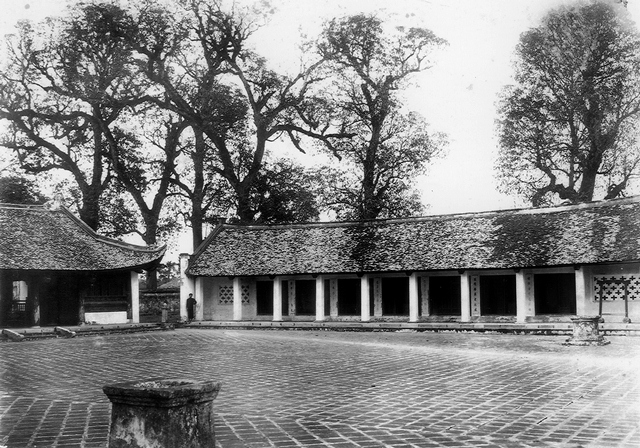
Nhà Hữu vu
After 1945, Van Mieu - Quoc Tu Giam was the principal worshipping place, so the only activities held at Van Mieu, were offering ceremonies to Confucius and Confucian scholars. It is noted that President Ho Chi Minh went there to conduct the Autumn offering ceremony on 21st October 1945 and the Minister of the Interior of the Democratic Republic of Vietnam, Huynh Thuc Khang organized the Autumn offering ceremony on 22nd September 1946. These events affirmed the significance of the role and great value of Van Mieu - Quoc Tu Giam for the national culture in a new historical situation.
After September 1946, the organization of offering ceremonies was held according to the national democracy and progressiveness of the government of the Democratic Republic of Vietnam. An offering ceremony was organized once a year on the date of Confucius’ birth (27 August). The rules and mode of the conduct of the ceremony were simple. Instead of lying prostrate, the participants of the ceremony needed to kneel down and they could wear western costumes. The offerings were also simple, practical, mainly flowers and fruit.
During the war of French resistance (1946-1954), Van Mieu - Quoc Tu Giam was almost destroyed. At the beginning of the national war of colonial resistance (1946-1947), the Khai Thanh Shrine and East and West wings in the Great Sanctuary Section were damaged.
To protect the vestige of Van Mieu - Quoc Tu Giam, some people who had responsibility for the national culture, founded “Van Mieu học Hiệp hội (Van Mieu study Association) with the purpose of the restoration and maintenance of the vestige. “Van Mieu study Association” made a great contribution to the preservation of the vestige until the day of liberation for Hanoi (1954).
In 1954, after taking over the Capital, the Culture branch in Hanoi authorized the restoration of Van Mieu. The Left and Right wings in Dai Thanh courtyard were then restored.
On April 28, 1962 Van Mieu - Quoc Tu Giam was ranked as a National Historical and Cultural Vestige by the Ministry of Culture of Vietnam.
On April 25, 1988, the Center for Cultural and Scientific Activities Van Mieu - Quoc Tu Giam was founded, its office is located inside the vestige; it assumes the task of preservation, restoration, management and exploitation of the vestige and brings into play the values of Van Mieu - Quoc Tu Giam of building modern Vietnamese culture.
VAN MIEU – QUOC TU GIAM DURING THE PERIOD 1802-1945
Under the Nguyen dynasty, Thang Long was not considered as the capital, but it became the center of the Hoai Duc prefecture, later belonged to Northern Citadel region. During this period, Van Mieu was called Van Mieu Bac Thanh and later changed its name to “Van Mieu Hanoi”. Quoc Tu Giam and became the school of Hoai Duc prefecture and developed into the Khai Thanh Shrine dedicated to Confucius’ parents.
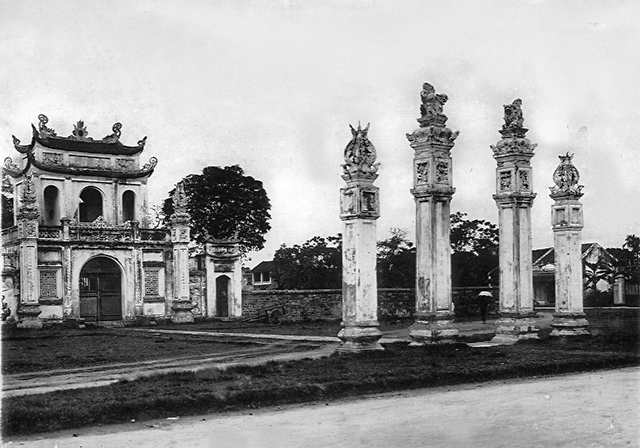
During this time, Van Mieu Hanoi was dedicated to Confucius and his 4 best disciples in the Great Sanctuary. The East and West wings were for the worship of 72 Confucian sages. The Khai Thanh Shrine was a place for honoring Confucius’ parents. However this vestige no longer had the function of an advanced educational center in the country, but with its special significance Van Mieu of the Northern Citadel region was paid attention and was restored during the Nguyen dynasty.
In 1805, the Khue Van Cac (constellation pavilion) was constructed by Nguyen Van Thanh, the chief of the Northern Citadel region at Van Mieu. It is such a unique architectural project: it is a wooden square pavilion with double roofs of pipe shaped tiles; it was erected on a square foundation tiled with Bat Trang bricks. The pavilion was built on 4 square brick pillars. The edges of the pavilion are wooden, its roofs were covered with pipe shaped tiles and 4 circular windows attached with spikes radiating outward, symbolizing the shining Khue constellation, that “monitors literature” which gives high regard to the Confucian educational center, and this has contributed to increasing the cultural and artistic values of Van Mieu - Quoc Tu Giam.
In 1808, after the construction of Van Mieu in the Capital Hue, the Nguyen dynasty ordered Van Mieu should be in different localities with Van Mieu of the Northern Citadel region honoring the tablet of Confucius, but not for worshiping his statue. If any place had statues they had to look for a clean land to bury them. Hence, Van Mieu had only worshipping tablets of Confucius and Confucian sages.
In 1827, under the reign of the King Minh Menh, an order was given to collect printing blocks of Ngu Kinh (Five Classics) and Tu Thu Dai Toan (Complete Four Books) and Vo Kinh Truc Giang in Van Mieu of the Northern Citadel region and bring them to Quoc Tu Giam in the capital of Hue. In 1833, the Great House of Ceremony and the Great Sanctuary were repaired and repainted; the surrounding walls of Van Mieu were rebuilt. In 1858, two pavilions on the right and left housing steles were constructed, with 11 rooms each. In 1863, Hoang Giap (official doctoral laureate), treasurer of Hanoi Le Huu Thanh and An sat (the title of feudal provincial civil mandarins in charge of criminal cases) Dang Ta raised fund to rebuild 4 pavilions, two on each side, with 11 rooms each for the protection of the doctoral laureates’ steles.
After the Patenôtre Treaty (1888), the French completely ruled Hanoi. During the period 1888-1945, Van Mieu – Quoc Tu Giam had the most changes of its history. Van Mieu was turned into a French military area, then a dispensary to isolate patients affected by cholera in Hanoi. Specifically, the French protectorate used a large part of the area in the North of this site for the planning of streets. Due to the enduring struggle of the people of Hanoi to protect this vestige from the French invasion, the French military decided to return this vestige for the local authorities to control; thus offering ceremonies were restored in Van Mieu - Quoc Tu Giam.
During the period 1888-1945, Van Mieu was under restoration for different periods in 1888, 1897-1901, and in 1904-1909. The last biggest restoration of Van Mieu in 1888 was recorded on the wooden board with the Chinese characters “Dai Thanh Gate” (Great Synthetic Gate) and on the horizontal board with the Chinese characters: “Van The Su Bieu” (the everlasting exemplary educator). Moreover, to comfort Vietnamese, the Minister plenipotentiary of the Northern region provided finance for the repairing of worshipping rooms, the buying of ceremonial tools and asked for the yields collected from the surrounding land with an area of over 12.300 m2 for the management and restoration of Van Mieu. In 1906, Van Mieu – Quoc Tu Giam was ranked as a historical and cultural vestige by the General Governor to Indochina.
Van Mieu - Quoc Tu Giam under the Nguyen dynasty (1802-1945) had to overcome many ups and downs; however this vestige was always preserved, maintained and well deserved as the quintessential educational and cultural center of the nation.
VAN MIEU - QUOC TU GIAM UNDER LE TRUNG HUNG DYNASTIES
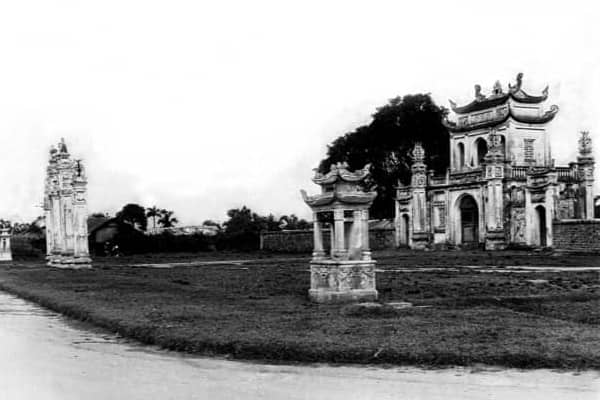
VAN MIEU - QUOC TU GIAM UNDER LE SO - MAC DYNASTIES
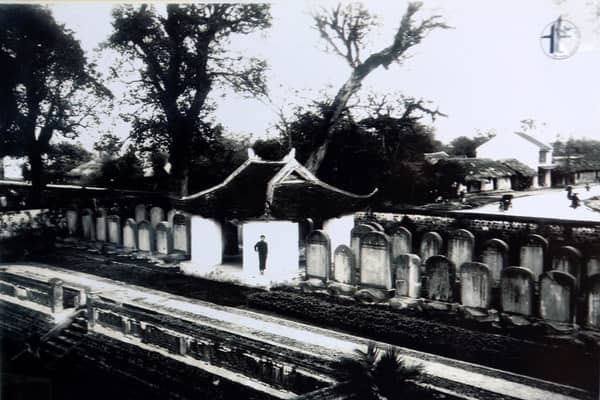
VAN MIEU - QUOC TU GIAM UNDER LY, TRAN, HO DYNASTIES
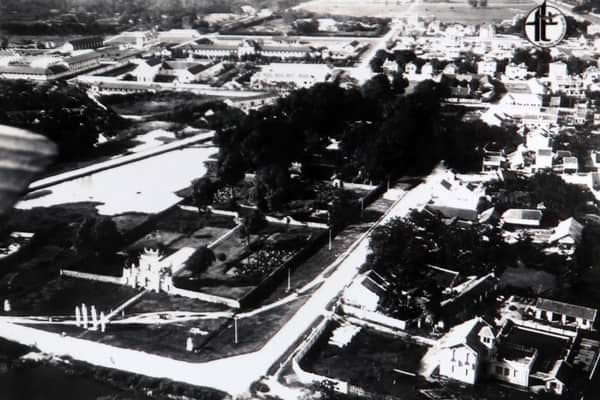
The Temple of Literature was established under the reign of Ly Thanh Tong, the second year of the year of the Dog, the year of the second year of the Spirit (1070), a place of worship of Confucius, Chu Cong and Tu Phe (the four excellent students of Confucius were Nhan Tu, Tang Tu and Tu Tu and Mencius), and the Seven Sage Sages (72 typical Confucian houses were honored as the Sage), and also the place where Prince Crown Prince Ly Can Duc went to study. Quoc Tu Giam was founded under Ly Nhan Tong, the first year of the first Vu Anh Chieu Thang (1076) was the place for literate officials and children of the Royal Family, the Great Prince in the Capital to study. When newly established, the size of the Temple of Literature - Quoc Tu Giam was still modest, but following the development of Confucian status in society, the Temple of Literature - Quoc Tu Giam was gradually paid attention to and expanded. In the Tran dynasty, although Buddhism was still thriving, although it was very disturbed by the resistance wars against the Nguyen Mong army, the Tran kings were still interested in the Temple of Literature - Quoc Tu Giam and Confucian education. In 1236, the royal court took Pham Ung Than to hold the position of Thuong Thuong and De Quoc Tu Vien to oversee the study at the National Academy. The court allowed the restoration of Quoc Tu institute in 1243, and took a photo of the statue of Chu Cong, Confucius and Manh Tu in 1253 to worship and let the Confucian scholars come to Quoc Tu institute to teach the Four Books and the Six Sutras. The establishment of the National Academy (Giam (school) was changed into a institute) as a learning place for literate officials in the localities and the king's children, the high official in the imperial capital marking the maturity as well as the big role. Great Temple of Literature - Quoc Tu Giam in this period. The Temple of Literature under the Tran dynasty has been beautifully renovated
